#wild animals 1997
Explore tagged Tumblr posts
Text
⭐A Past Life of Jeon Jungkook - Oracle and Tarot Reading
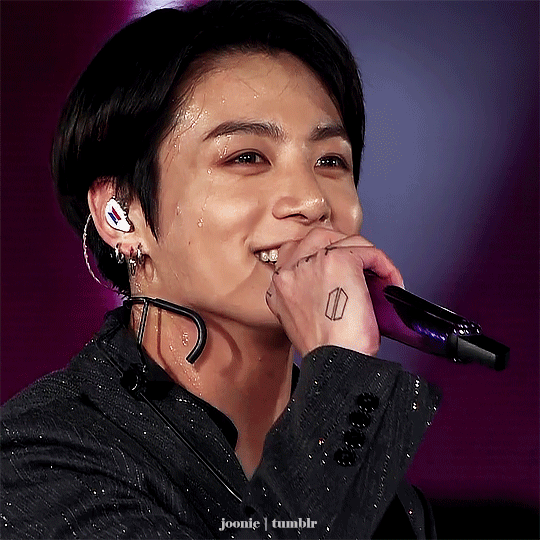
[A view of a Past Life of Jeon Jungkook, born September 1, 1997 — Virgo. The Past Life Reading is an intuitive and channeled reading that pinpoints the most prominent past life that is currently influencing an individual’s current incarnation. For this reading, I use six decks: the Rider-Waite Tarot, The Linestrider Tarot, Moonology Oracle, Wisdom of The Oracle, The Spirit Animal Oracle, Wild Unkown Archetypes, Tarotwave, Wisdom of The Oracle, Black Moon Lilith Astrology Cards, Chakra Reading Cards, and the Sacred Geometry Activations Oracle deck. This reading lasted 3 hours.]
Reading Performed: October 17, 2024
Originally Posted: October 26, 2024
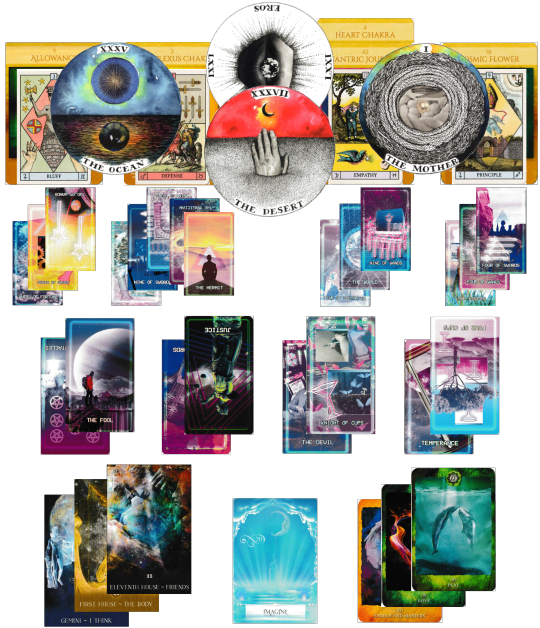

Overall Progression: The Ocean + The Desert/Eros + The Mother
The past life that came through for Jungkook is a very interesting one that seemed centered on development and personal progression of the soul through a human experience. This lifetime was one of late-stage awakening or a higher awareness toward the end of life that set the stage for the current lifetime where, alongside a working lifetime, he is experiencing make-ups or rewards for prior work experiences. Human connection and the appreciation for honest and open connection with deep understanding is rooted in this past life where he became very disconnected from this aspect that is true to him on a soul level within all lifetimes.
The overall progression of this lifetime is laid out above starting with The Ocean, which then moves into The Desert. Immediately it gave this sense of the soul drying up or becoming disconnected from the conscious mind completely after originally coming in relatively aware and heart-centered. In the image of The Desert we see a hand reaching out of the sand towards a burning moon or an eclipse — I was taking this more as a burning moon as it reflects the diamond in Eros, representing the loss of a counterpart connection. Essentially, a soul mate connection was in line in this lifetime, a higher counterpart that was present in other lifetimes, but due to the disconnect of the soul, the soul connection with the counterpart was also lost.
It was very clear that this connection lingered in the mind and body, suggesting that connection had been made, however, it was lost rather quickly or didn’t move beyond a certain stage. There was a part, a lingering shred of the soul that was still reaching out toward that counterpart while the rest of his consciousness sank into heavier spaces that were dictated by blind faith, conformity, and a deliberate separation from emotions.
The lifetime concludes with The Mother, where I was seeing the pearl in the center as reflecting the burning moon and the diamond in Eros. This is where it was shown that either while still alive or after death, there was a marker put on this lifetime for a redo, specifically around this connection. He planted a seed of this connection and then, on multiple levels, seems to have locked it in and ensured that out of everything, this would be something he would experience, pursue, and treasure. One of the elements of his current state of being, his appreciation of connection and relationships, which is still very clear within his soul ties, is present now specifically to aid in his ability to recognize this connection when it is presented to him.
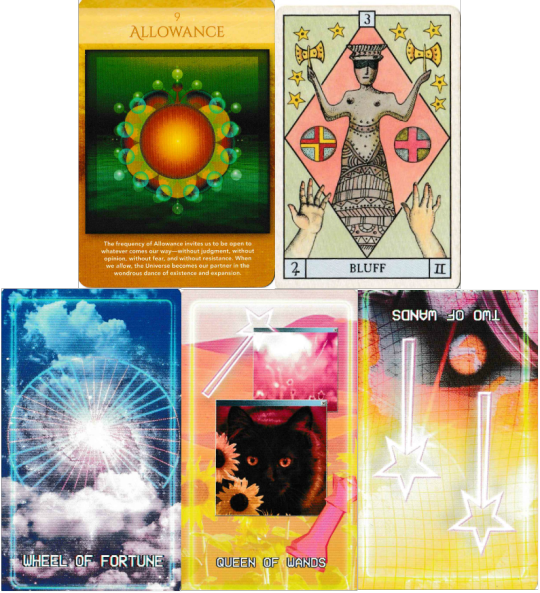
Childhood
This was a little sad to read into because it seems like he really didn’t have a chance at all in this past life to be his own person. Granted, this was a deliberate setting for development, and he seemed to move through it relatively fine at first, but there’s a kind of softer innocence to how and why he was so easily guided toward something that was very against his nature. The combination of Allowance and Bluff read very literally in the realm of naivety, allowing others to bluff, moving in a carefree way through the words of other people. Falling in line, being convinced, and following laid out paths would have been very instinctual for him while on a more intuitive level, he would have felt uneasy.
Overall Energy: Allowance + Bluff
Timeline: Wheel of Fortune + Queen of Wands + 2 of Wands (rev.)
The timeline lays it out with the Wheel of Fortune and the Queen of Wands merged together as a symbol of outer authority, that may be connected primarily to his family first in this past life. It feels like the Wheel and the Queen represent someone else sitting in the driver’s seat of his life, and right from the beginning, straight from birth, were in control. This may explain why, in spite of that inner unease and disagreeing, he still was so easy to guide into certain things. He really didn’t know how to do or say anything against authority.
Because of this, his childhood was left to him in the form of the reversed 2 of Wands, which settled as the inability to dream or the refusal to dream, to think of anything far off in the future, or even something he would do the following day, as it was always understood that someone else was laying out his day for him.
I do think as well that his more stubborn and carefree approach to life now in his current state stems from this, ensuring that he can well and truly be completely in control of his life and how it plays out day to day.
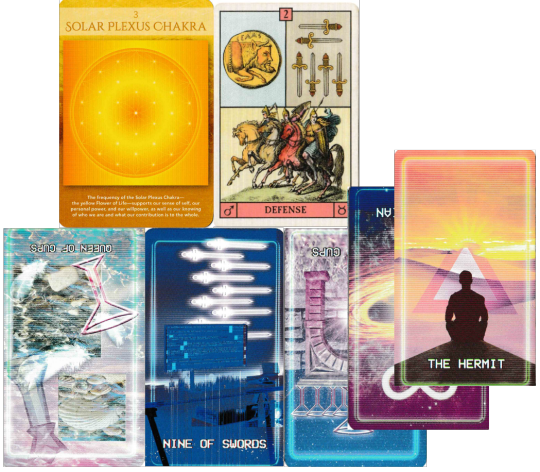
Teen Years
The teen years was when shit seemed to really hit the fan when it came to the loss of soul connection. It was a temporary state, but it was quite a heavy one with very deliberate cutting off of the emotional center. It was very clear to me that this was related to some kind of military work, I was seeing it more as knights or some kind of guardianship of people of higher status, royal guards or something in that realm. It was a job that he was connected to through family, a kind of role that is passed through families specifically for the sake of trust and status.
Overall Energy: Solar Plexus + Defense
Timeline: Queen of Cups (rev.) + 9 of Swords + 9 of Cups (rev.) / The Magician (rev.) / The Hermit
Solar Plexus and Defense show a relatively unconscious state of being, a very externalized and forceful mode that he was in, very much leaning into a hardened masculine energy, drifting very far away from any internal awareness. The Solar Plexus is involuntary projection (as opposed to the Sacral Chakra, which is more intentional projection) and Defense brings Mars and Taurus — Cardinal Fire and Fixed Earth — together in absolute extremes.
In the timeline, we have this space and time initiated with the reversal of the Queen of Cups, which is the cutoff of internal awareness. This feels a lot like going through training or some kind of trial work where it was made clear that his own sensitivities could not be supported here and could not be supportive of what was expected of him.
This gave way to the 9 of Swords, which is quite a heavy mental load that strings together grief, paranoia, fear, and depression. This is mirrored then by the reversed 9 of Cups. Just as he intentionally cut off his internal space, he very knowingly cut himself off from a lot of what he did allow himself to dream about, which seems to be very limited to his relationship with this soul counterpart, which at this point still feels very distant. With The Magician in reverse alongside it, it is a known loss of power or control, coming across as him knowing that in stepping into line here, he would lose his wand, any ability he had at all to make his own wishes come true. This is then followed by The Hermit upright, a future prospect of always being alone.
It came through that the person he was hoping to be with was someone who was very peaceful and at ease in the heart, very similar to his own soul, but without the filtration or limitation that he was given in this lifetime. It feels like it may have been an “admire from afar” kind of situation with a few blips of sparks here and there. There was hope and a sense of freedom that was either gained from this person or was just something that this person inspired within himself that made it possible for him to dream of his future with this person. Because this person was practically the embodiment of peace, however, there was a major split here on multiple levels where they came to be entirely incompatible, at least from his perspective.
As a side note, somewhere within this timeframe between the teen years and adulthood, within the space of The Desert specifically, it seems he may have killed someone while out and about on a mission or in battle. I was seeing it in my head as him looking over a body on the ground in the middle of a wide open field. It wasn’t clear to me if I was seeing it as just the two of them in this field because that’s what it actually was, of it that’s just how it felt for him in the moment — going into shock during a battle and only being able to focus on the one person he actually did kill in that moment. There were more deaths, but it seems the first is what lingered the most, going numb to the rest.
This seemed to be the main source of the grief and depression, potential PTSD in the 9 of Swords. It also seems to be one of the major points in his mind that affirmed for him that coming together again with this soulmate was completely impossible. He held onto that guilt, but it did wake him up a bit and put things into perspective. He, at some point, maybe years beyond this first death, quit this job and truly did become The Hermit. There’s a major separation from others, although he may not have literally been alone the whole time, just unable to make deeper connections out of fear, shame, or just a lingering sense of inner disconnect that he could never extend past himself.

Adult Years
Moving into the adult years, which actually feel more like the end of life (with the End of Life section feeling like matters left to the soul after death), there was a reawakening that came through what feels like an existential crisis. On some level, it feels like The Hermit took on the energy of the 9 of Swords and sought out shelter in the church in the 5 of Pentacles. Not a literal church, maybe an institution, maybe an inner temple of sorts that was reached at a point of desperation.
Overall Energy: Heart Chakra + Tantric Journey + Empathy
Timeline: 5 of Pentacles + The World + 9 of Wands
The Heart Chakra and Tantric Journey as the overall energy of this period of his life are mind breaking. Connection to the heart, or the inner world, has been reestablished, but it feels like returning to ruins. The Heart represents something more physical or conscious, while Tantric Journey represents something higher, energetic, or out of body. On some level, I want to say that it feels like time travel, as if he experienced some sort of break from reality and traveled back in his mind to when he “had a heart,” which was connected to this person who was lost to him in the time. The Empathy card, the imagery on it, feels like revisiting a friend and hearing whispers. The bird holding the pearl makes me think of the pearl in The Mother, something representing this other person, who was a reflection of his own soul, heart, or inner world.
The 5 of Pentacles itself is connected to spiritual and financial lack, an emptiness or feeling of being incomplete. In this space, if you get stuck, a person can seek out a lot of comfort or distraction in order to cope with or do away with the feeling of not having what you really want. Following this, The World feels connected to the idea of some kind of break from reality, as the grid and field in the image extend past and break around the world itself. I feel this as a breaking point in which he could not be with the world, could not stay in reality, could not function properly. There was stuff coming through again that would lead me to think he was dealing with PTSD.

The 9 of Wands is a card about paranoia and negative anticipation, hypervigilance. In the traditional Rider-Waite image, there is a man who stands guard over his own domain after having been attacked or facing a battle of some kind. Constantly on foot, on guard, and looking over his shoulder. In the image in the Tarotwave deck, we see a group of wands standing around a computer to watch another wand that appears to break out of the screen. Breaking out of the screen lines up with the feeling of breaking out of reality, being watched by other people while doing it. He could have potentially been institutionalized or was watched over by family or friends.
The 9 of Wands’ display of breaking from reality, alongside The World and the 5 of Pentacles, does feel like the point of death or the energy that led to his death. If he did take his own life, it’s not entirely clear if he knew what he was doing or if it was a sudden accident.
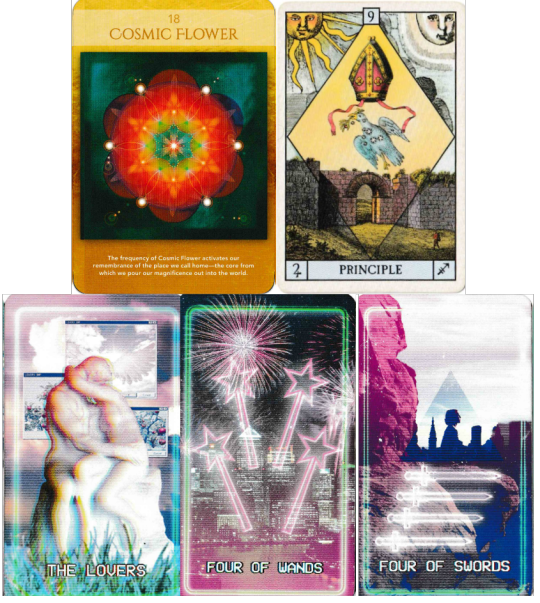
End of Life
Because this portion of the reading registers as being after the point of death rather than the death itself, I’m wondering if he spent some time wandering after death, either by choice or as a soul lost and confused after an upsetting or disconnected passing. There’s something quite solemn about the combination of Cosmic Flower and Principle. They feel very big, expansive, stimulated, but very quiet and wide open, like walking through a field on your own and seeing nothing but the horizon on all sides. This feels like a wandering soul. Both cards are also connected to number 9 with Principle being connected to the 9th House through Sagittarius and Cosmic Flower being number 18, 9 multiplied and 9 from 1 and 8 together. This settles into the idea of expanding within the point of finality or having some kind of further awakening process happening whilst in a state of limbo.
Overall Energy: Cosmic Flower + Principle
Timeline: The Lovers + 4 of Wands + 4 of Swords
The timeline is less of a timeline and more of a designated checklist. Things that were pondered on, dreamed of, hoped for, and thus the seeds that were planted by the soul still wandering on earth, that would one day be able to be harvested and experienced during a separate lifetime. It doesn’t feel like it was an intentional planting whilst in a wandering state, it feels more like it was dreamed of so much that it just started taking root, and then when his soul crossed over and he was back to planning his lifetimes out, he designated a space and time, now within his current working lifetime, for these things to play out.
The 4 of Swords is a wide-sweeping one, which is connected to rest, relaxation, recuperation, healing, and meditation. His spirit was resting in a state of disconnect, it was uneasy and stagnant rather than fully at ease, which may explain why he may have gotten a bit stuck or lost within this timeframe — he thought he was dreaming, didn’t know he was dead, may have thought he was hallucinating or dissociating. The “permanent break from reality” felt to him in the moment like he was caught up in a very deep sleep and a lucid dream. Going back to his childhood with the reversed 2 of Wands, the matter of knowing even then that there was no point in dreaming, thinking, or planning for his future, he gave himself permission, whilst believing he was in a literal dream, to imagine and maybe play out on some level, the fantasies he had with this other person.
The Lovers is coming through very literally, especially with the image on the card. It’s a statue, a sculpture of two people embracing, something someone dreamed up but may have not experienced. The image is held in high regard and locked into place. The expression of love alone would be projected well enough through the 2 of Cups, but the fact that The Lovers is coming through here like this shows that there was a demand to see it, to feel it, to experience it fully, not just as a daydream.

The 4 of Wands is just the same with both the image here and the traditional image coming to mind. Both of them reflect celebration, but the traditional image also suggests a welcoming. Two people are on the other side of the threshold, which feels like him watching something through a window, through a screen, through his own imagination. He’s not just seeing his person welcoming him back, he’s seeing his own body welcoming him as well. It’s like part of him knew or was imagining that in some other world, they were together, and that other version of him was waiting for him to plug in and start living.
The 4 of Wands is also often connected to soulmate reunion and unification, through the representation of the two people placed within the four wands, which can appear as 1111 or 11:11, denoting parallel progression and mirrored souls, or counterparts. The number 4 is also the number of foundation and can represent the soil that the seed of The Lovers was planted in. With this recognition of welcoming on both sides, I would think that at this point he would have either found peace and crossed over after the passing of his person. It's possible the other person's soul, who was more awake and at ease in passing, came and got Jungkook out of his little limbo situation. This would take us into the 4 of Swords again in a different way, this time implying actual soul rest, the point of crossing over completely and ending this lifetime fully.
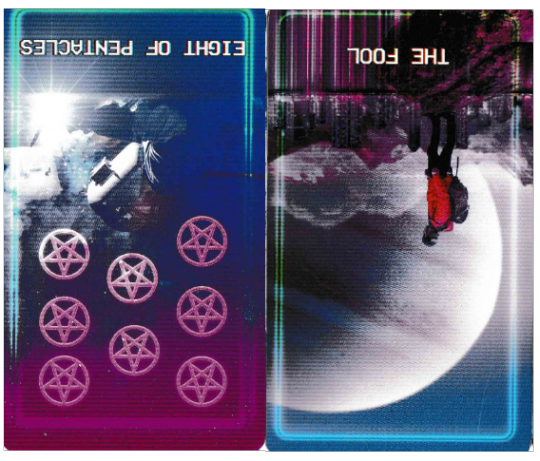
With the reversed 8 of Pentacles, there was a lot of deep disappointment toward himself for not being able to “do the basics,” which don’t actually seem to be very basic to me. This goes back to him not being able to handle or cope with his job, something that it seems most of his family did. This is very specific to harming or killing other people — it was considered a basic aspect of the job, it was something he couldn’t cope with doing in spite of doing it many times, and therefore he saw himself as someone who couldn’t keep up or couldn’t perform as well. The 8 of Pentacles here gives a feeling of a broken conveyor belt in a factory, a person unable to fall in line with others, a loss of self-control.
How He Saw Himself: 8 of Pentacles (rev.)
State of The Soul: The Fool (rev.)
The state of the soul reflects major restriction of potential, which goes back to the lack of autonomy that was prominent throughout this lifetime. The Fool, when upright, represents pure potential, and in reverse, it represents something that feels more like a doll, someone or something at the mercy of the outside energy, the outside potential, rather than what can come from within, what can come from personal choice. It seems to come down to him having gotten very comfortable with the idea of being able to follow rules and follow the leader in every way that when he hit this wall of his own limitations, he felt deeply unnerved by this. It’s almost like he was so controlled by others that it seemed like when he was left on his own to perform “simple tasks” he was unable to do anything. I think he thought of himself as someone who couldn’t do the job unless someone was holding his hand, and with that came a lot of insecurity and self-hatred around the emotional and more sensitive spaces within himself, which at some point he lived in denial of.

Unfortunately, it would seem most people saw him as someone coming undone, and with Justice in reverse, this is somewhat how he was supposed to be seen. Both cards here represent the mind splitting or unraveling. Justice itself feels more like the connection, the line of mediation between the inner world and the outer world, or the real world and the dream world (hallucinations/flashbacks), either collapsed or bled between the two leaving no distinction. The 10 of Swords is more visceral, feeling like the mind and nervous system becoming overwhelmed and glitching out, slowly being eroded away and then completely destroyed. From the outside looking in, he looks like someone who went completely insane in an "inevitable" way, while he himself was still fighting to keep himself above water. It feels like people looked at him as a lost cause long before he truly was, and that came down to him simply not being able to follow commands anymore.
How Others Saw Him: 10 of Swords (rev.)
How He Was Meant To Be Seen: Justice (rev.)

Again, this was a lifetime centered around development, so while this does seem a bit heavy, it is something he wanted to experience on a soul level with the intention of it contributing to his future navigation in working lifetimes — most likely a crash course in how to avoid the loss of autonomy, identity, and the heart.
Goal: The Devil
What Was Accomplished: Knight of Cups
The Devil representing the goal is more centered in the image, where the devil is shown to be whispering together with the man, both images distorted as the identity and self-awareness are lost. This feels like a reflection of the Wheel of Fortune and the Queen of Wands, which felt like someone else sitting in the driver’s seat of his life from the very beginning. The goal was to experience a complete loss of control that led to self-destruction so that these things could be navigated around more smoothly, which is what is shown to be accomplished with the Knight of Cups.
A more fluid, heart-centered energy that is self-guided and dedicated to making dreams a reality. This is all represented in the Knight of Cups, and I do think we see that energy in him now in his current lifetime. The Knight of Cups is also considered the most romantic of the Knights, usually associated with Prince Charming or the “knight in shining armor.” It’s a set mission, one he set for himself on a soul level, to curate a life and experience that is purely under his own rule, with a focus on personal foundations, love, connection, and proper unification with his person. I’m seeing that one of the reasons, on a higher level, that things seem to fall into place for him so easily is because he’s quite literally done it all before and can bypass a lot of the challenges one might face. He’s, on multiple levels, in the driver’s seat of his life and has a full view of the navigation system, with a clear vision of the end goal, which is centered on The Lovers and the 4 of Wands.
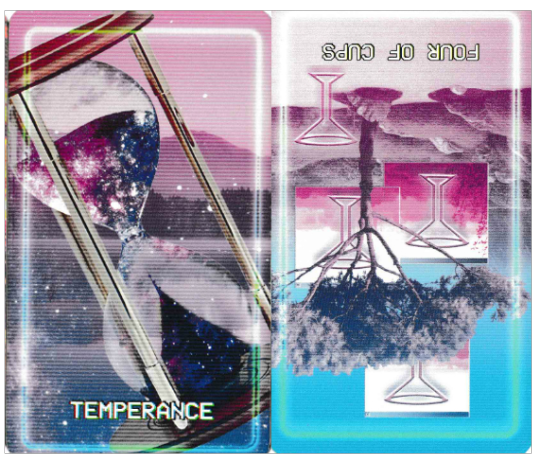
The significant soul connection that was experienced in this past life is represented by Temperance, a person displayed as being balanced between the physical and spiritual, a soul fully integrated into the body. What was gained from this connection, based on the reversed 4 of Cups, is actually what was lost or never found. Again, there was a foundation being laid within this past life that led to him being able to very much so appreciate love and connections in all subsequent lifetimes, so this aspect of separation being “what was gained” still makes sense within this lifetime and can be looked at positively on a soul level, while also registering as incomplete on a conscious level within these memories.
Significant Soul Connection: Temperance
What Was Gained: 4 of Cups (rev.)
Added note: I ended up doing an additional reading out of curiosity to see the energy signatures of this connection in the current lifetime in order to explore any interesting reflections or carry-overs from this past life. That reading will be included at the end of this one for reference.

Tools/Lessons Being Accessed: Gemini — I think + 1st House — The body + 11th House — Friends
The lessons being accessed here reflect the two main points of crossover that I recognized in the beginning — personal autonomy and a deep appreciation for relationships and connection overall. Gemini and the 1st House, with the key phrases “I think,” and “the body,” register very clearly as an independent mind guiding an independent body, a life dedicated to personal achievement and satisfaction alongside and in front of many people that he would feel supported and validated by. Anyone that wouldn’t support him on this would be in direct conflict with his very soul, something that in this current life he would not be able to look past. He may have moments (or had, in the past) where he allows things to slip for the sake of avoiding confrontation or hoping to see the best in someone or something, but there’s a very clear personal boundary that is laid and is meant to really solidify and become completely non-negotiable.

Outlook: Imagine
This was quite an energy to see rush through with this card. This set refers to the outlook Jungkook may have in this current lifetime based on his soul’s experience in the previous one. Here, with Imagine, there is a major emphasis on the aspect of dreaming, of looking ahead and seeing the infinite possibility in himself and everyone and everything around him. In comparison to this past life where, from the beginning, he was not able to dream or even plan his own future, here everything with Imagine is shown to be entirely within the realm of his own will. So long as he can see it in his mind, he will be able to bring it to life, for himself and others around him. This will cast a lot of inspiration out into the world, this energy is something that ripples out and expands on itself.

Something To Remember: Angels and Masters + Love + Play
This set would be for Jungkook if he were actually receiving this reading, something for him to remember or take note of from this past life, usually something that the soul wants to cement into the conscious mind so that it doesn’t get lost, forgotten, or bypassed along the way. Here, the Angels and Masters cards I was seeing as reflecting The Magician and Temperance. The Magician is a card that comes out for Jungkook a lot nowadays (it used to be The Fool with the Ace of Wands, or the Page of Wands), and of course, Temperance is here representing his soul counterpart or the person he will experience union with.
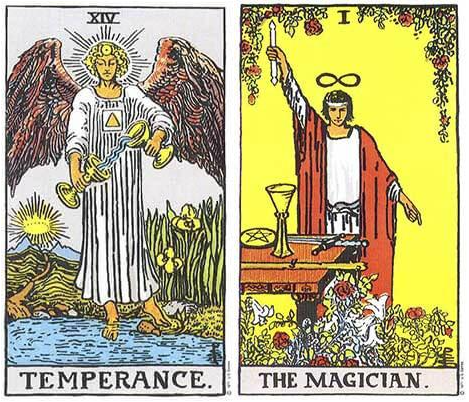
For reference, I was seeing the images of these two cards reflected in the image of Angels and Masters. Temperance’s wings and the chakras represent The Magician’s personal and external alignment, both acting as conduits of energy. One a bit softer, the other a bit more hands on and direct. It blends very nicely divine masculine and feminine energy that is expressed on both sides, showing individual soul development has been curated to a high degree. In the main card, “Angels” refers mainly to Temperance, and “Masters” refers mainly to The Magician, but both of them would be considered both as they both, out of body, would be “Angels” and on earth, as humans, would both be considered “Masters” of their own souls. Their progression, potentially parallel, would be evident.
Alongside the reminder of this significant connection, he also has two Heart Chakra cards with Love and Play, which really just felt like a marker of affirmation, his higher soul coming through and saying, “yes, you’ll know when it’s right because THIS is what it feels like.” It’s pure love, genuine love that comes very naturally, instinctually, and a vibrancy that brings him back to, or keeps him in a healthy state of playful youth, always ready to move and jump and yell and just really let himself be with this other person. The same feeling would be there for the other as well. It would be very natural, casual, simple, but potent and undeniable.

The closing messages here, which would still just be for him to take, emphasizes again the importance of maintaining that personal direction, that conscious connection to his own soul, his own personal direction and desire. Along with that, the Spider Spirit affirms that this is the lifetime in which he is to make his dreams a reality, living out his designs and giving himself free reign within all of it.
Closing Messages
Full Moon in Pisces — Balance spirituality and practicality
Spider Spirit — Make your dreams real.

Temperance’s Energy Signature In The Current Lifetime
The energy signature of the person represented by Temperance is very clear, but there is a heaviness to the energy especially in relation to The Tear, Saturn Return, and Concentration. There’s a lot of internal struggle with this person, but struggles that they are able to manage and move beyond quite easily, although they benefit most, or are able to help themselves the most when they are with others or are being supported.
The Tear and the Third-Eye Chakra show a deeply internalized person, someone who may find it difficult to speak or express themselves fully on their own, but are very capable of seeing into other people, very observant and very aware of what other people are feeling or the general vibes of an environment. There are heavier emotions that seem to flood the space with The Tear, but I’m seeing this in a way where the water droplet of The Tear, green and gold like the Heart and Solar Plexus Chakras, magnify or clear the lens of the Third Eye. Their own emotional upsets help them to feel and understand others more instinctually rather than intuitively.
Flexibility covers internal and external aspects — showing a flexible individual in the way that they speak to others, the way they listen to others, but also in the way that they operate within themselves. This can also be taken literally with a person who has a flexible body as I’m seeing this relating to how they take care of themselves with an effort to stay fit or stay relaxed and well managed through physical activity. With the Flexibility card specifically, yoga, dancing, or light cardio would be more the speed, activity that has the potential to relieve stress rather than add strain through something like weight training.
In comparison to Jungkook, the Flexibility card seems to hold more of that Divine Feminine energy as well, it’s the receptive space as well as a space of operation. The internalized flexibility is in the way they receive others, how they communicate with others, and how they interact with their environments. They are more receptive to, and one could say potentially at the mercy of, the energy or the people around them. I feel like this could have been a problem that has already been solved or is managed more consciously now as I keep seeing the person in the image of Flexibility wobbling before straightening back up like something else straightened out their spine.
Saturn Return is at the center of the spread and feels very significant in relation to time. There is a peak point either for this person or potentially for both of them around the time of the Saturn Return, but more specifically the culmination point which can fall around the 30th birthday specifically. It’s a point of transition out of a time of strenuous effort toward balancing things within yourself, and between yourself and the rest of the world (20s) and into a mode of personal awareness and a sense of personal liberation (30s). These two may meet each other in their 30s or if they’ve already met, which is possible due to The Tribe card, they may reach a certain peak or highlight of their relationship while they are in their 30s.
I also feel that for this person individually, the presence of Saturn here at the center shows that this person has been through their fair share of trials in their life and has built themselves up with it very nicely and is to be rewarded for that effort in the time of their 30s. Especially with the context of The Tear, Third Eye, and Flexibility, this person has had to learn how to manage themselves and other people, overcome a lot of personal, internal obstacles as well, and will be solidifying personal foundations of peace later on if they have not already begun doing it. In other words, very strict boundaries, a very close and limited circle of friends (The Tribe), words and actions would be very carefully chosen, and so on.
The Tribe card is very interesting because I immediately got thrown to the idea of soul family or cosmic DNA, connections that are very clear and strong due to the significant bonds that are beyond the physical. Considering that Jungkook, along with the other members, are here on a working lifetime, it is right to assume they did not come in alone, they came in with a lot of people that would help to ensure they are able to do what they need to do together and individually. This Temperance person is someone who is part of that group, is well intertwined with the space and if they are not already part of it, would be someone who fits in very easily, as if they were there from the beginning.

With The Tribe, considering how easily the connections fit and seem to work within the same space, I assumed that this Temperance person is probably an entertainer of some kind or works in media to a degree, and Concentration seems to support that. The images on the card are what I’m most focused on, as there is this sense of a witch hunt or someone being attacked and strung up with words and emotions. The mouth on top belongs to the Temperance person while the little green goblin devil thing are like envious projections from others onto this person, literally trying to put words in their mouth or trying to corrupt their image. The way the goblin is waving its hands it’s like, “See guys! This person did this, and then that, and they said this and then this happened! They’re awful!!” It’s all made up, exaggerated, or severely distorted, but the swords fly in any way with an effort to cut the person’s mouth. I’m taking that literally in the sense of hoping to silence them as well as very literally tarnish their image, destroy some level of beauty they wish wasn’t there.
If you think of the goblin thing as a little demon, and Temperance as an angel, the “default hatred” toward Temperance makes sense, but this is being displayed amongst humans, so it’s coming across as Temperance just kind of existing and jealous and hateful people going out of their way to destroy this person’s existence to some degree. It seems very on par with what celebrities, especially in the idol world go through.
The star at the bottom, strung up in a spider’s web, also comes from the effort of others to subdue or tone down the image of Temperance. There’s something more “close to home” with the web where it feels like they are not only being held down by the web, but they are also holding the web in place from the center. It’s a sense of self-sacrifice, and I’m seeing this as falling into some kind of extremism where, essentially, Temperance is aware, potentially due to the image above, that their natural image (an angel of fluidity and balance) is not something people enjoy and therefore they lean a little more into one side over the other. This takes the star’s color from a bright white (a blend of all the colors) to a solid red (centered more in the Root Chakra, more superficial, more image-oriented).
It is quite nice though if you consider that no matter how much other people try and destroy their image, and no matter how much they limit themselves for the sake of peace, they remain a star, the remain as some kind of celestial image that you can imagine floating brightly in the sky, looking down on everything with a sense of understanding and compassion.
The Ace of Pentacles is the last card for this person’s energy center and this may also contribute to them being a person in entertainment or a public figure of some kind as I was seeing this in connection to money as well as production. It’s both the work they do and the money they earn. Both are quite big and come from a “heavenly place” or an “otherworldly place.” There’s something about a natural or necessary exchange, as in this person gives the pentacle to the world, a product, a body of work, and then the world gives back to them a gold coin, a reward, money, success. It’s done quite big and quite successfully because it is supported on a higher level and fueled by the soul. There’s something of innovation or inspiration involved as well where their work or what they contribute to the world should be seen as and treated as a gift from an angel — people may really feel this to be true, and this may be why there are little goblins running around trying to tarnish it. On another level, they see this person’s goodness as a weapon against their own efforts to stagnate and destroy, to live miserably, to believe only in hopelessness, imbalance, lack, and a loss of identity.
The last two cards were pulled with the intention of catching an echo of a whisper, something that this person on some level would say or has said to Jungkook himself. There they have the Badger Spirit which says, “be fearless and bold,” and the New Moon in Capricorn, “your hard work is paying off.”
There certainly is a lot of support there in those words, generating what feels like a driving force or immense inspiration. The way this person has a gift for the world — that gift is received ten times over by Jungkook and the effects of this person would be quite noticeable to him, but still remain questioned by others. In this, they may fuel each other where Jungkook is inspired and pushed forward and the Temperance person is validated, appreciated, and in that is encouraged to keep going, keep building, keep delivering that fluid balance into the world.
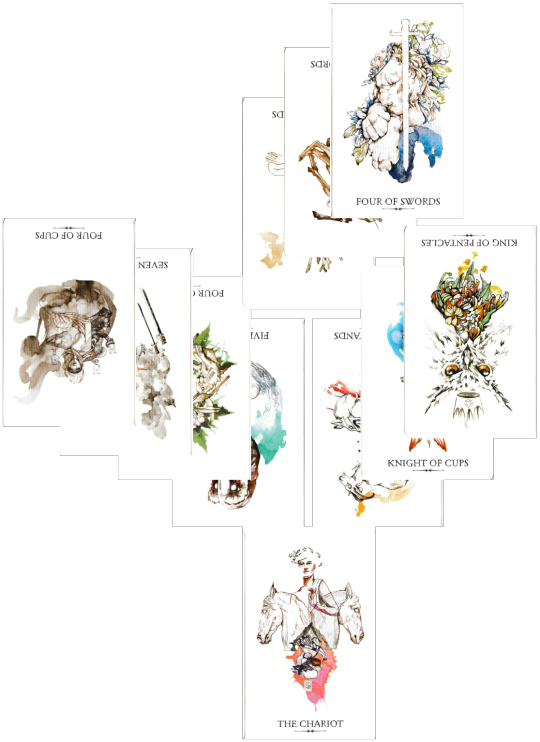

Since we can’t be sure if they know each other already or if this connection is waiting in the wings, this section is more zoomed out and is reflecting what their souls or Higher Selves are contributing or pushing down for the other person’s conscious level reception. Here, Kook has the 5 of Cups in reverse. The 5 of Cups, when upright, is a person stuck in grief, insecurity, or a sense of hopelessness after experiencing some kind of upset that affected them deeply. It represents a person focusing only on flaws, low points, downfalls, and failures, losing focus on or going completely blind to hope, potential, or their own capability. This would reflect the Temperance person’s deeper inner sensitivity, connecting to The Tear specifically.
The Magician (Jungkook): 5 of Cups (rev.)
Temperance: 7 of Wands (rev.)
In reverse, Jungkook flushes out that dark water, and feels to shield this person from the swords and cut them from the bindings shown in Concentration. He lightens their load and opens their eyes again to a brighter future, giving them the strength they need to keep going.
In the same way, Temperance contributes the reversed 7 of Wands. Upright, the 7 of Wands is about fighting to keep your place, feeling competitive with others, or even just competitive with the self, feeling the strenuous urge to do more, be more. I am feeling this as very self-focused, as if he’s fighting with himself, or fighting his own sense of limitations. Where Temperance's sense of limitation could stop them from moving out of fear of confrontation, Jungkooks sense of limitation has the potential to make him burn himself out trying to perfect himself beyond those perceived limitations. Both are a bit exaggerated but not without intention — these perceived limitations were put on them both by other people, they just respond to them differently.
Temperance, as they reversed the 7 of Wands for Jungkook, cools the ego, soothes the tension and seems to apply some of their own flexibility to his energy, mind, and body. The same way Temperance is validated by Jungkook, Jungkook is validated by Temperance and is encouraged to move forward. Actually, it’s more like he’s ENSURED to move forward. There was never an issue of him potentially stopping, there was just a potential for him to be forced to stop due to burn out or injury.
In this, these two exchange Water and Fire between the Cups and the Wands. On their own, Temperance carries more Water, more fluidity, more feminine receptivity, while Jungkook carries more Fire, externalized action, masculine projection. They carry both energies very well, again showing the level of development in both of these souls, but they both lean a bit in either direction. With the reversed 5 of Cups, we see Jungkook illuminate and purify the heavier dark water that Temperance is dealing with. It doesn’t go away, it doesn’t evaporate, it simply is purified, cleared enough that Temperance can get back to the normal state of flow, clarity, and awareness. This goes into The Tear, the water acting as a magnifier for the Third-Eye — the deeper emotions are necessary and their ability to balance them is key, but when things get heavier, the water gets darker and the visibility of what’s really there, even within the self can become distorted.With the reversed 7 of Wands, Temperance runs Water through Jungkook’s system. Not snuffing out the flames, but cooling the generators that were steaming hot and about to crack.
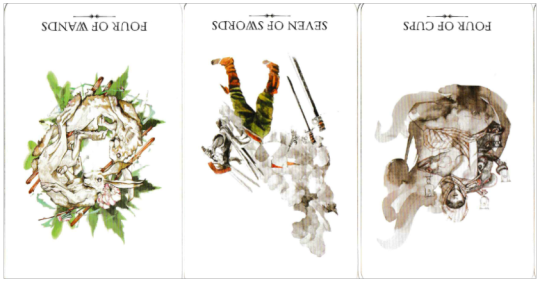
How Kook Sees Temperance:
4 of Wands (rev.) + 7 of Swords (rev.) + 4 of Cups (rev.)
This is quite funny because all throughout this I’ve been trying to figure out if this is a connection that is already in play on a conscious and physical level, or if I’m just picking up on the inherent soul connection. With these cards it’s like saying, “No, I’m not WAITING for this person, they’re right here! No, I’m not SNEAKING AROUND with this person, they’re right here! No, you’re not MISSING anything, it’s right here!”
I’m thinking more of the Rider-Waite cards with this, so I’ll explain each of them for reference:

The 4 of Wands is connected to higher soul mate connections and soul counterparts with the four wands in the foreground often being seen as 1111 or 11:11, implying parallel paths of development or work that are leading to a point of unification. The two people in the background, within this context, can be considered the souls of the two individuals, already together on another level, waiting to celebrate the physical and conscious level unity. In this case, that would imply that the 4 of Wands says the connection is going to happen, that the paths are parallel but have not crossed yet. With this card reversed, it’s saying, in a very sly way, that this connection has already come to be, this union has already happened, there is no waiting.

The 7 of Swords shows a person sneaking around, specifically stealing swords and doing so in a way that’s going to trip him up. If we consider the potential of Temperance also being in the entertainment industry, there may be a need to keep things quiet, but there is no desire, with the card in reverse, to go unnoticed. The swords are still held by the blade, words, confirmation are still held back, but there is no desire to hide or “sneak around.” This connection is a visible connection to both him and other people.

The 4 of Cups is more externalized, as in you can imagine the floating cup in front of the man with his eyes closed as another version of the 7 of Swords — you’re not missing anything, it’s right in front of you, they are showing this connection, it’s just not making a lot of noise, it’s not being said out loud. When upright, the cup goes unnoticed by the man with his eyes closed, either because he’s meditating and expecting to receive this cup in his own mind, or he’s fallen asleep and hasn’t noticed it. Here, for this, it feels like the man is straight up refusing, crossing his arms, closing his eyes, and shaking his head. It makes me feel a little sad because it’s leaving the hand in the cloud to question, “why did you accept those cups, but you won’t accept ours?”
It’s like they were signaling or trying to slyly put themselves out there, but people refused or maybe even denied the connection in terms of their companies or management refusing a public relationship. On some level people are refusing them while accepting others and it’s very frustrating and confusing, specifically to Jungkook. It seems like, from that higher perspective, Temperance understands it, does not like it but understands it and is more compliant with the idea of needing to sneak or keep things hidden. There actually does seem to be a lot of frustration in this set now that I’m lingering on this one — “No, you’re not MISSING anything, it’s right here!”
In reverse, Jungkook is really like, “I can see this person clear as day, they’re right here, they’re right next to me, why are you acting like you can’t see them? Why are you acting like you can’t see us?”
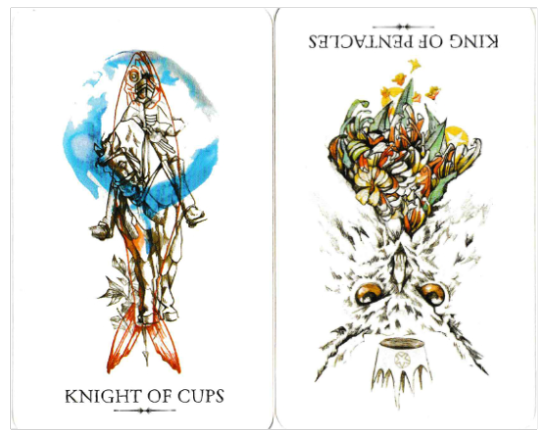
How Temperance Sees Jungkook:
Knight of Cups + King of Pentacles (rev.)
When it comes to how Tempernace sees Jungkook, there’s an interesting reflection here that seems to relate to Jungkook’s view of Temperance, or more specifically his view of their relationship. When these cards came out, the Knight of Cups was hidden underneath the reversed King of Pentacles. The Knight of Cups is what Temperance knows of Jungkook — the Knight of Cups combined Fire and Water and seems to reflect the “knight in shining armor,” “prince charming” energy in the way they feel to be rescued from their own dark waters, literally swept up on the boat shown in the image.
However, the King of Pentacles in reverse registers as very stubborn, moving from mutable energy (Fire and Water) fully into the space of Fixed Earth energy, double Earth, very hardened and not very receptive. It’s that frustration from his set. It’s like when he’s with Temperance, he’s fully in that fluid state, more at ease and even more mature, but when he’s looking out at the world, looking out at these aspects of restriction, he’s very frustrated and it seems to trigger his ego, potentially triggering the soul in relation to autonomy and being able to live and operate freely under his own rule, literally taking the crown away from the King.
Again, it seems like Temperance is more understanding and receptive to the idea that they have to keep things quiet or reserved for the sake of safety, their careers, and so on. I imagine since Jungkook seems so opposed to it, Temperance is probably thinking more about him than themselves, and that’s probably due to them having been stabbed and strung up already in Concentration. They’ve felt that restriction already in other ways, they’ve had to learn flexibility because of it, and it seems they don’t want Jungkook to have to bend and nearly break like that, and instead wants to kind of set perimeters and then ensure freedom within those parameters, ensure freedom within their connection.

Current State: The Chariot
The current state of their connection being represented by The Chariot is really nice as it showcases that they are in fact on the same path now. With soul counterparts, the parallel paths eventually merge into one higher path that affirms and supports soul purpose, or in their case soul mission. This is not an intersecting path, meaning this seems to be a potentially one and done deal unless they choose to separate on a conscious level. In other words, if it was purely up to their souls to decide, they are together now and will be together until their lifetimes here are over. When one dies, they will stay with the one who is still living until they pass.

Highest Potential:
10 of Wands (rev.) + 10 of Swords (rev.) + 4 of Swords
The highest potential of their connection is genuinely lovely and makes me want to cry a bit. This is all centered around finding peace and being able to rest, either within each other, within this relationship, or this is something they are both building up and will one day be able to fully step into. The two 10s here are the “bad ones,” opposing the peace and fulfillment of the 10 of Pentacles and 10 of Cups. The 10 of Wands is strain and a lot of physical exertion, something that feels very connected to Jungkook’s frustration and urge to perfect himself. The 10 of Swords is about undeniable ends and destruction of reality, seeming to connect back to the swords flying in Concentration, the aspect of being strung up, bound, and abused by others' words and actions toward Temperance. Both of these are reversed showing that the highest potential of their connection involves relief from these burdens.
This is then doubled down on with the 4 of Swords which is literally just about resting after a major upset, relaxing and trying to heal, preparing for what is to come next. It’s a nap for the mind, body, and soul.
Again, this may be something they are already experiencing in small doses with each other, literally finding peace or a place to “nap” within each other, but this could also be something they are trying to build and move toward, creating a permanent state of rest or peace.
This brings to mind, as a kind of end goal, the complete transition of the two reversed 10s here and the upright 10 of Cups and 10 of Pentacles. For the sake of comparison, here are all four cards from the Rider-Waite deck:
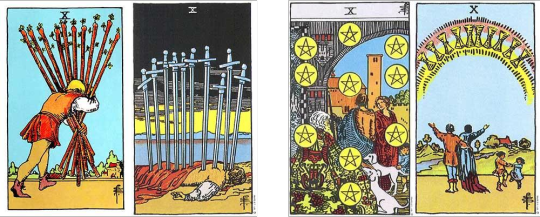
Again, the 10 of Wands seems to be connected more to Jungkook and the 10 of Swords is more connected to Temperance. Take notice of how they are alone in those images, while the other two show partners and family, potentially The Tribe. The reversal of these cards feels like being able to find peace and retreat from these energies within each other when they can, but there also feels to be an open space or a desire to make this permanent and create the 10 of Pentacles and the 10 of Cups. You can imagine them on their own as having already both achieved for themselves the 9s of Cups and Pentacles — wish fulfillment and independent success, but the 10s are everlasting and hold matters of legacy and true soul fulfillment.
The 10 of Pentacles is more externalized and has to do with legacy and building up wealth, status, and solid foundations for themselves and their family that can be trusted, that can not be undone or taken away. The 10 of Cups is more internalized and represents absolute bliss, absolute personal, internal happiness and satisfaction with what is there. Both of these cards imply family, marriage, and growing old together.
That's all I have for this one, thanks for reading!
Shop | Website (currently down)
#tarot reading#oracle reading#idol reading#celebrity reading#past life reading#jeon jungkook#jungkook#bts#kim namjoon#rm#namjoon#jin#yoongi#suga#hoseok#jhope#jimin#park jimin#taehyung#bts v
104 notes
·
View notes
Text
Did the ancient Celts really paint themselves blue?
Part 2: Irish tattoos


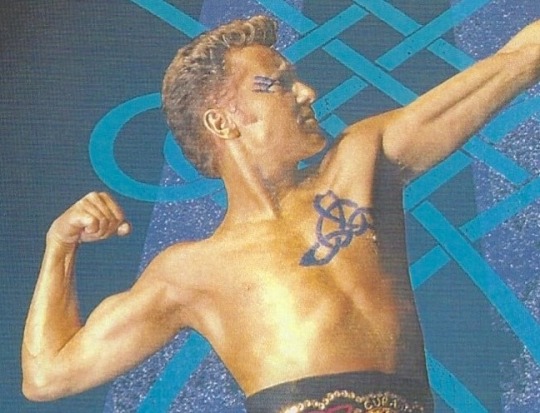
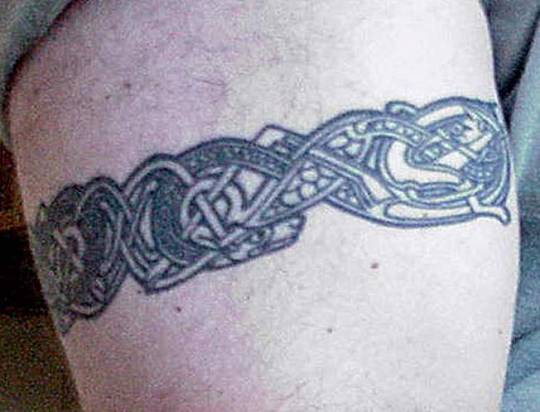
Clockwise from top left: Deirdre and Naoise from the Ulster Cycle by amylouioc, detail from The Marriage of Strongbow and Aoife by Daniel Maclise, a modern Celtic revival tattoo, Michael Flatley in a promotional image for the Irish step dance show 'Lord of the Dance'
This is my second post exploring the historical evidence for our modern belief that the ancient and medieval Insular Celts painted or tattooed themselves with blue pigment. In the first post, I discussed the fact that body paint seems to have been used by residents of Great Britain between approximately 50 BCE to 100 CE. In this post, I will examine the evidence for tattooing.
Once again, I am looking at sources pertaining to any ethnic group who lived in the British Isles, this time from the Roman Era to the early Middle Ages. The relevant text sources range from approximately 200 CE to 900 CE. I am including all British Isles cultures, because a) determining exactly which Insular culture various writers mean by terms like ‘Briton’, ‘Scot’, and ‘Pict’ is sometimes impossible and b) I don’t want to risk excluding any relevant evidence.
Continental Written Sources:
The earliest written source to mention tattoos in the British Isles is Herodian of Antioch’s History of the Roman Empire written circa 208 CE. In it, Herodian says of the Britons, "They tattoo their bodies with colored designs and drawings of all kinds of animals; for this reason they do not wear clothes, which would conceal the decorations on their bodies" (translation from MacQuarrie 1997). Herodian is probably reporting second-hand information given to him by soldiers who fought under Septimius Severus in Britain (MacQuarrie 1997) and shouldn't be considered a true primary source.
Also in the early 3rd century, Gaius Julius Solinus says in Collectanea Rerum Memorabilium 22.12, "regionem [Brittaniae] partim tenent barbari, quibus per artifices plagarum figuras iam inde a pueris variae animalium effigies incorporantur, inscriptisque visceribus hominis incremento pigmenti notae crescunt: nec quicquam mage patientiae loco nationes ferae ducunt, quam ut per memores cicatrices plurimum fuci artus bibant."
Translation: "The area [of Britain] is partly occupied by barbarians on whose bodies, from their childhood upwards, various forms of living creatures are represented by means of cunningly wrought marks: and when the flesh of the person has been deeply branded, then the marks of the pigment get larger as the man grows, and the barbaric nations regard it as the highest pitch of endurance to allow their limbs to drink in as much of the dye as possible through the scars which record this" (from MacQuarrie 1997).
This passage, like Herodian's, is clearly a description of tattooing, not body staining or painting. That said, I have no idea of tattoos actually work like this. I would think this would result in the adult having a faded, indistinct tattoo, but if anyone knows otherwise, please tell me.
The poet Claudian, writing in the early 5th c., is the first to specifically mention the Picts having tattoos (MacQuarrie 1997). In De Bello Gothico he says, "Venit & extremis legio praetenta Britannis,/ Quæ Scoto dat frena truci, ferroque notatas/ Perlegit exanimes Picto moriente figuras."
Translation: "The legion comes to make a trial of the most remote parts of Britain where it subdues the wild Scot and gazes on the iron-wrought figures on the face of the dying Pict" (from MacQuarrie 1997).
Last, and possibly least, of our Mediterranean sources is Isidore of Seville. In the early 7th c. he writes, "the Pictish race, their name derived from their body, which the efficient needle, with minute punctures, rubs in the juices squeezed from native plants so that it may bring these scars to its own fashion [. . .] The Scotti have their name from their own language by reason of [their] painted body, because they are marked by iron needles with dark coloring in the form of a marking of varying shapes." (translation from MacQuarrie 1997)
Isidore is the earliest writer to explicitly link the name 'Pict' to their 'painted' (Latin: pictus) i.e. tattooed bodies. Isidore probably borrowed information for his description from earlier writers like Claudian (MacQuarrie 1997).
In the 8th century, we have a source that definitely isn't Romans recycling old hearsay. In 786, a pair of papal legates visited the Anglo-Saxon kingdoms of Mercia and Northumbria (Story 1995). In their report to Pope Hadrian, the legates condemn pagans who have "superimposed most hideous cicatrices" (i.e gotten tattoos), likening the pagan practice to coloring oneself "with dirty spots". The location of the visit indicates that these are Anglo-Saxon tattoos rather than Celtic, but some scholars have suggested that the Anglo-Saxons might have adopted the practice from the Brittonic Celts (MacQuarrie 1997).
A gloss in the margin of the late 9th c. German manuscript Fulda Aa 2 defines Stingmata [sic] as "put pictures on the bodies as the Irish (Scotti) do." (translation from MacQuarrie 1997).
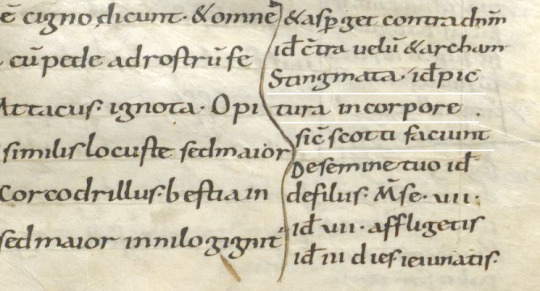
Fulda Aa 2 folio 43r The gloss is on the left underlined in white.
Irish Written Sources:
Irish texts that mention tattoos date to approximately 700-900 CE, although some of them have glosses that may be slightly later, and some of them cannot be precisely dated.
The first text source is a poem known in English as "The Caldron of Poesy," written in the early 8th c. (Breatnach 1981). The poem is purportedly the work of Amairgen, ollamh of the legendary Milesian kings. In the first stanza of the poem, he introduces himself saying, "I being white-kneed, blue-shanked, grey-bearded Amairgen." (translation from Breatnach 1981)
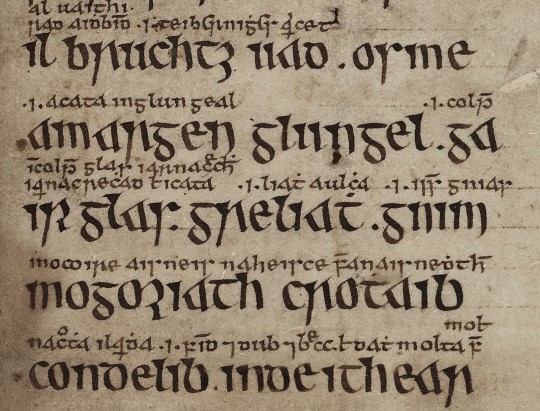
The text of the poem with interline glosses from Trinity College Dublin MS 1337/1
The word garrglas (blue-shanked) has a Middle Irish (c. 900-1200) gloss added by a later scribe, defining garrglas as: "a tattooed shank, or who has the blue tattooed shank" (Breatnach 1981).
Although Amairgen was a mythical figure, the position ollamh was not. An ollamh was the highest rank of poet in medieval Ireland, considered worthy of the same honor-price as a king (Carey 1997, Breatnach 1981). The fact that a man of such esteemed status introduces himself with the descriptor 'blue-shanked' suggests that tattoos were a respectable thing to have in early medieval Ireland.
The leg tattoos are also mentioned c. 900 CE in Cormac’s Glossary. It defines feirenn as "a thong which is about the calf of a man whence ‘a tattooed thong is tattooed about [the] calf’" (translation from MacQuarrie 1997)
The Irish legal text Uraicecht Becc, dated to the 9th or early 10th c., includes the word creccoire on a list of low-status occupations (Szacillo 2012, MacNeill 1924). A gloss defines it as: crechad glass ar na roscaib, a phrase which Szacillo interprets as meaning "making grey-blue sore (tattooing) on the eyes" (2012). This sounds rather strange, but another early Irish text clarifies it.
The Vita sancti Colmani abbatis de Land Elo written around the 8th-9th centuries (Szacillo 2012) contains the following episode:
On another time, St Colmán, looking upon his brother, who was the son of Beugne, saw that the lids of his eyes had been secretly painted with the hyacinth colour, as it was in the custom; and it was a great offence at St Colmán’s. He said to his brother: ‘May your eyes not see the light in your life (any more). And from that hour he was blind, seeing nothing until (his) death. (translation from Szacillo 2012).
The original Latin phrase describing what so offended St Colmán "palpebre oculorum illius latenter iacinto colore" does not contain the verb paint (pingo). It just says his eyelids were hyacinth (blue) colored. This passage together with the gloss from the Uraicecht Becc implies that there was a custom of tattooing people's eyelids blue in early medieval Ireland. A creccoire* was therefore a professional eyelid tattooer or a tattoo artist.
A possible third reference to tattooing the area around the eye is found in a list of Old Irish kennings. The kenning for the letter 'B' translates as 'Beauty of the eyebrow.' This kenning is glossed with the word crecad/creccad (McManus 1988). Crecad could be translated as cauterizing, branding, or tattooing (eDIL). McManus suggests "adornment (by tattooing) of the eyebrow" as a plausible interpretation of how crecad relates to the beauty of the eyebrow (1988). The precise date of this text is not known (McManus 1988), but Old Irish was used c. 600-900 CE, meaning this text is of a similar date to the other Irish references to tattoos.
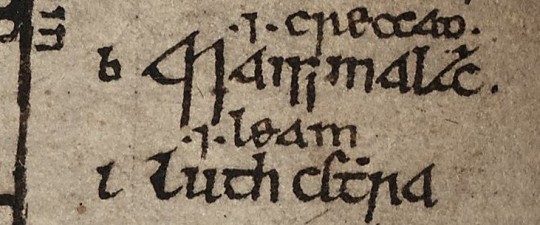
Kenning of the letter 'b' with gloss from TCD MS 1337/1
There is a sharp contrast between the association of tattoos with a venerated figure in 'The Caldron of Poesy', and their association with low-status work and divine punishment in the Uraicecht Becc and the Vita. This indicates that there was a shift in the cultural attitude towards tattoos in Ireland during the 7th-9th centuries. The fact that a Christian saint considered getting tattoos a big enough offense to punish his own brother with blindness suggests that tattooing might have been a pagan practice which gradually got pushed out by the Catholic Church. This timeline is consistent with the 786 CE report of the papal legates condemning the pagan practice of tattooing in Great Britain (MacQuarrie 1997).
There are some mentions of tattooing in Lebor Gabála Érenn, but the information largely appears to be borrowed from Isidore of Seville (MacQuarrie 1997). The fact that the writers of LGE just regurgitated Isidore's meager descriptions of Pictish and Scottish (ie Irish) tattooing without adding any details, such as the designs used or which parts of the body were tattooed, makes me think that Insular tattooing practices had passed out of living memory by the time the book was written in the 11th century.
*There is some etymological controversy over this term. Some have suggested that the Old Irish word for eyelid-tattooer should actually be crechaire. more info Even if this hypothesis is correct, and the scribe who wrote the gloss on creccoire mistook it for crechaire, this doesn't contradict my argument. The scribe clearly believed that eyelid-tattooer belonged on a list of low-status occupations.
Discussion:
Like Julius Cesar in the last post, Herodian of Antioch c. 208 CE makes some dubious claims of Celtic barbarism, stating that the Britons were: "Strangers to clothing, the Britons wear ornaments of iron at their waists and throats; considering iron a symbol of wealth, they value this metal as other barbarians value gold" (translation from MacQuarrie 1997). If the Britons wore nothing but iron jewelry, then why did they have brass torcs and 5,000 objects that look like they're meant to attach to fabric, Herodian?
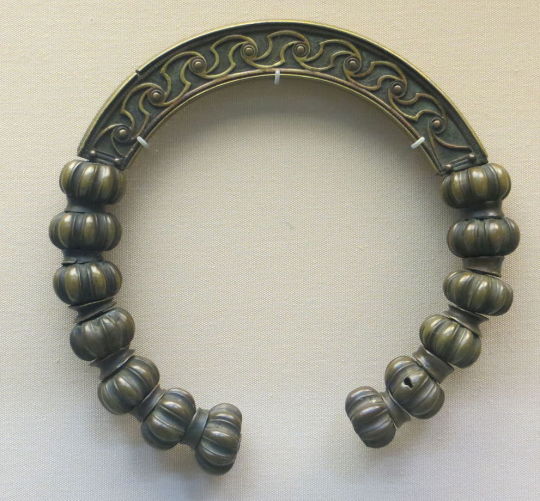
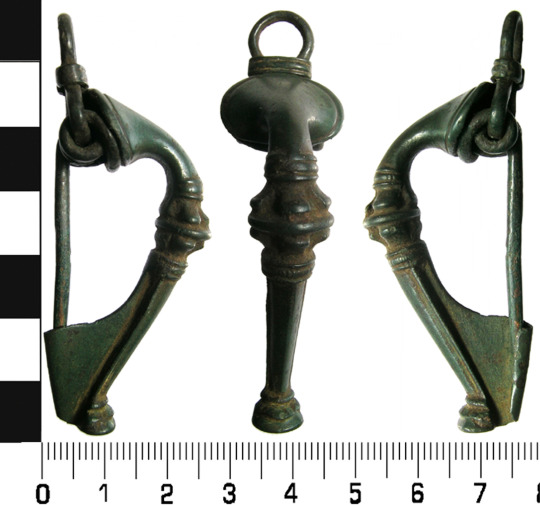
Brass torc from Lochar Moss, Scotland c. 50-200 CE. Romano-British trumpet brooch from Cumbria c. 75-175 CE. image from the Portable Antiquities Scheme.
Trumpet brooches are a Roman Era artifact invented in Britain, that were probably pinned to people's clothing. more info
Although Herodian and Solinus both make dubious claims, there are enough differences between them to indicate that they had 2 separate sources of information, and one was not just parroting the other. This combined with the fact that we have more-reliable sources from later centuries confirming the existence of tattoos in the British Isles makes it probable that there was at least a grain of truth to their claims of tattooing.
There is a common belief that the name Pict originated from the Latin pictus (painted), because the Picts had 'painted' or tattooed bodies. The Romans first used the name Pict to refer to inhabitants of Britain in 297 CE (Ware 2021), but the first mention of Pictish tattoos came in 402 CE (Carr 2005), and the first explicit statement that the name Pict was derived from the Picts' tattooed bodies came from Isidore of Seville c. 600 CE (MacQuarrie 1997). Unless someone can find an earlier source for this alleged etymology than Isidore, I am extremely skeptical of it.
Summary of the written evidence:
Some time between c. 79 CE (Pliny the Elder) and c. 208 CE (Herodian of Antioch) the practice of body art in Great Britain changed from staining or painting the skin to tattooing. Third century Celtic Briton tattoo designs depicted animals. Pictish tattoos are first mentioned in the 5th century.
The earliest mention of Irish tattoos comes from Isidore of Seville in the early 6th c., but since it seems to have been a pre-Christian practice, it likely started earlier. Irish tattoos of the 8-9th centuries were placed on the area around the eye and on the legs. They were a bluish color. The 8th c. Anglo-Saxons also had tattoos.
Tattooing in Ireland probably ended by the early 10th c., possibly because of Christian condemnation. Exactly when tattooing ended in Great Britain is unclear, but in the 12th c., William of Malmesbury describes it as a thing of the past (MacQuarrie 1997). None of these sources give much detail as to what the tattoos looked like.
The Archaeology of Insular Ink:
In spite of the fact that tattooing was a longer-lasting, more wide-spread practice in the British Isles than body painting, there is less archaeological evidence for it. This may be because the common tools used for tattooing, needles or blades for puncturing the skin, pigments to make the ink, and dishes to hold the ink, all had other common uses in the Middle Ages that could make an archaeologist overlook their use in tattooing. The same needle that was used to sew a tunic could also have been used to tattoo a leg (Carr 2005). A group of small, toothed bronze plates from a Romano-British site at Chalton, Hampshire might have been tattoo chisels (Carr 2005) or they might have been used to make stitching holes in leather (Cunliffe 1977).
Although the pigment used to make tattoos may be difficult to identify at archaeological sites, other lines of evidence might give us an idea of what it was. Although the written sources tell us that Irish tattoos were blue, the popular modern belief that woad was the source of the tattoo pigment is, in my opinion, extremely unlikely for a couple of reasons:
1) Blue pigment from woad doesn't seem to work as tattoo ink. The modern tattoo artists who have tried to use it have found that it burns out of the person's skin, leaving a scar with no trace of blue in it (Lambert 2004).
2) None of the historical sources actually mention tattooing with woad. Julius Cesar and Pliny the Elder mention something that might have been woad, but they were talking about body paint, not tattoos. (see previous post) Isidore of Seville claimed that the Picts were tattooing themselves with "juices squeezed from native plants", but even assuming that Isidore is a reliable source, you can't get blue from woad by just squeezing the juice out of it. In order to get blue out of woad, you have to first steep the leaves, then discard the leaves and add a base like ammonia to the vat (Carr 2005). The resulting dye vat is not something any knowledgeable person would describe as plant juice, so either Isidore had no idea what he was talking about, or he is talking about something other than blue pigment from woad.
In my opinion, the most likely pigment for early Irish and British tattoos is charcoal. Early tattoos found on mummies from Europe and Siberia all contain charcoal and no other colored pigment. These tattoos range in date from c. 3300 BCE (Ötzi the Iceman) to c. 300 CE (Oglakhty grave 4) (Samadelli et al 2015, Pankova 2013).
Despite the fact that charcoal is black, it tends to look blueish when used in tattoos (Pankova 2013). Even modern black ink tattoos that use carbon black pigment (which is effectively a purer form of charcoal) tend to look increasingly blue as they age.
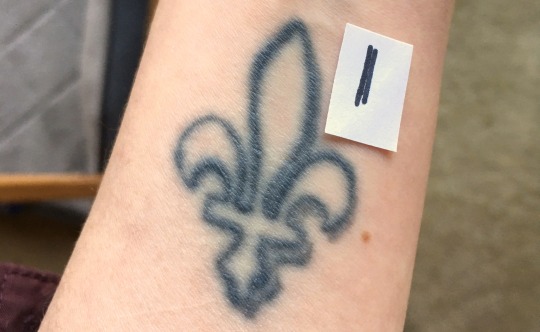
A 17-year-old tattoo in carbon black ink photographed with a swatch of black Sharpie on white printer paper.
The fact that charcoal-based tattoo inks continue to be used today, more than 5,000 years after the first charcoal tattoo was given, shows that charcoal is an effective, relatively safe tattoo pigment, unlike woad. Additionally, charcoal can be easily produced with wood fires, meaning it would have been a readily available material for tattoo artists in the early medieval British Isles. We would need more direct evidence, like a tattooed body from the British Isles, to confirm its use though.
As of June 2024, there have been at least 279 bog bodies* found in the British Isles (Ó Floinn 1995, Turner 1995, Cowie, Picken, Wallace 2011, Giles 2020, BBC 2024), a handful of which have made it into modern museum collections. Unfortunately, tattoos have not been found on any of them. (We don't have a full scientific analysis for the 2023 Bellaghy find yet though.)
*This number includes some finds from fens. It does not include the Cladh Hallan composite mummies.
Tattoos in period art?
It has been suggested that the man fight a beast on Book of Kells f. 130r may be naked and covered in tattoos (MacQuarrie 1997). However, Dress in Ireland author Mairead Dunlevy interprets this illustration as a man wearing a jacket and trews (Dunlevy 1989). Looking at some of the other figures in the Book of Kells, I agree with Dunlevy. F. 97v shows the same long, fitted sleeves and round neckline. F. 292r has long, fitted leg coverings, presumably trews, and also long sleeves. The interlace and dot motifs on f. 130r's legs may be embroidery. Embroidered garments were a status symbol in early medieval Ireland (Dunlevy 1989).

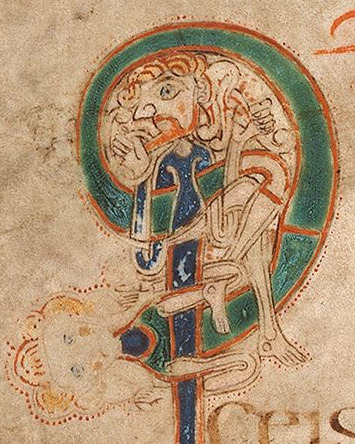

Left to right: Book of Kells folios 130r, 97v, 292r
A couple of sculptures in County Fermanagh might sport depictions of Irish tattoos. The first, known as the Bishop stone, is in the Killadeas cemetery. It features a carved head with 2 marks on the left side of the face, a double line beside the mouth and a single line below the eye. These lines may represent tattoos.
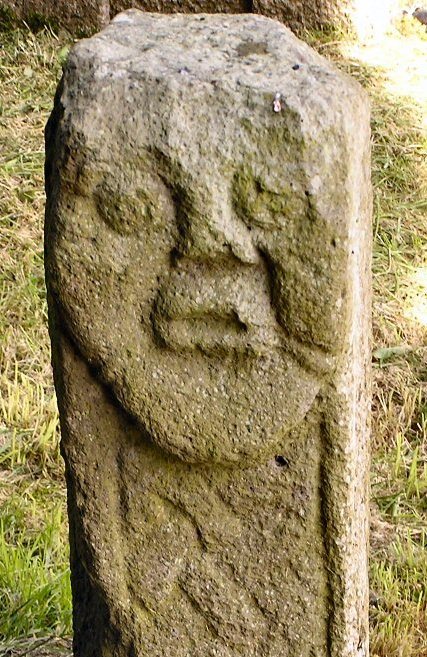
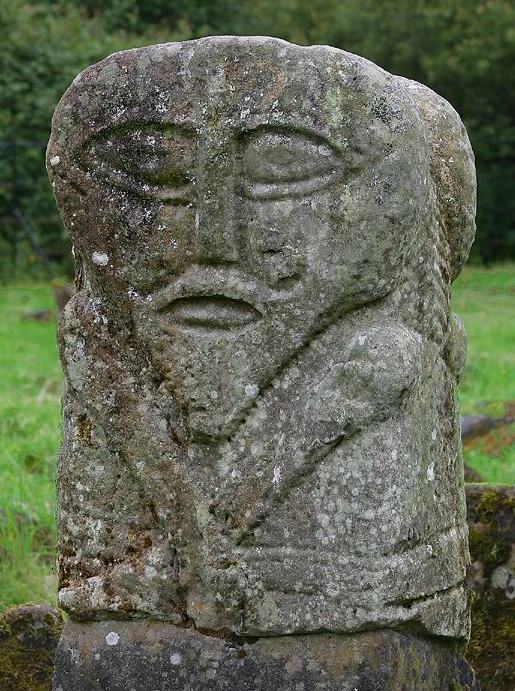
The second sculpture is the Janus figure on Boa Island. (So named because it has 2 faces; it's not Roman.) It has marks under the right eye and extending from the corner of the left eye that may be tattoos.
I cannot find a definitive date for the Bishop stone head, but it bears a strong resemblance to the nearby White Island church figures. The White Island figures are stylistically dated to the 9th-10th centuries and may come from a church that was destroyed by Vikings in 837 CE (Halpin and Newman 2006, Lowry-Corry 1959). The Janus figure is believed to be Iron Age or early medieval (Halpin and Newman 2006).
Conclusions:
Despite the fact that tattooing as a custom in the British Isles lasted for more than 500 years and was practiced by at least 3 different cultures, written sources remain our only solid evidence for it. With only a dozen sources, some of which probably copied each other, to cover this time span, there are huge gaps in our knowledge. The 4th century Picts may not have had the same tattoo designs, placements or reasons for getting tattooed as the 8th c. Irish or Anglo-Saxons. These sources only give us fragments of information on who got tattooed, where the tattoos were placed, what they looked like, how the tattoos were done, and why people got tattooed. Further complicating our limited information is the fact that most of the text sources come from foreigners and/or people who were prejudiced against tattooing, which calls their accuracy into question.
'The Cauldron of Posey' is one source that provides some detail while not showing prejudice against tattoos. The author of the poem was probably Christian, but the poem appears to have been written at a time when Pagan practices were still tolerated in Ireland. I have a complete translation of the poem along with a longer discussion of religious elements here.
Leave me a tip?
Bibliography:
BBC (2024). Bellaghy bog body: Human remains are 2,000 years old https://www.bbc.com/news/uk-northern-ireland-68092307
Breatnach, L. (1981). The Cauldron of Poesy. Ériu, 32(1981), 45-93. https://www.jstor.org/stable/30007454
Carey, J. (1997). The Three Things Required of a Poet. Ériu, 48(1997), 41-58. https://www.jstor.org/stable/30007956
Carr, Gillian. (2005). Woad, Tattooing and Identity in Later Iron Age and Early Roman Britain. Oxford Journal of Archaeology 24(3), 273–292. https://doi.org/10.1111/j.1468-0092.2005.00236.x
Cowie, T., Pickin, J. and Wallace, T. (2011). Bog bodies from Scotland: old finds, new records. Journal of Wetland Archaeology 10(1): 1–45.
Cunliffe, B. (1977) The Romano-British Village at Chalton, Hants. Proceedings of the Hampshire Field Club and Archaeological Society, 33(1977), 45-67.
Dunlevy, Mairead (1989). Dress in Ireland. B. T. Batsford LTD, London.
eDIL s.v. crechad https://dil.ie/12794
Giles, Melanie. (2020). Bog Bodies Face to face with the past. Manchester University Press, Manchester. https://library.oapen.org/viewer/web/viewer.html?file=/bitstream/handle/20.500.12657/46717/9781526150196_fullhl.pdf?sequence=1&isAllowed=y
Halpin, A., Newman, C. (2006). Ireland: An Oxford Archaeological Guide to Sites from Earliest Times to AD 1600. Oxford University Press, Oxford. https://archive.org/details/irelandoxfordarc0000halp/page/n3/mode/2up
Hoecherl, M. (2016). Controlling Colours: Function and Meaning of Colour in the British Iron Age. Archaeopress Publishing LTD, Oxford. https://www.google.com/books/edition/Controlling_Colours/WRteEAAAQBAJ?hl=en&gbpv=0
Lambert, S. K. (2004). The Problem of the Woad. Dunsgathan.net. https://dunsgathan.net/essays/woad.htm
Lowry-Corry, D. (1959). A Newly Discovered Statue at the Church on White Island, County Fermanagh. Ulster Journal of Archaeology, 22(1959), 59-66. https://www.jstor.org/stable/20567530
MacQuarrie, Charles. (1997). Insular Celtic tattooing: History, myth and metaphor. Etudes Celtiques, 33, 159-189. https://doi.org/10.3406/ecelt.1997.2117
McManus, D. (1988). Irish Letter-Names and Their Kennings. Ériu, 39(1988), 127-168. https://www.jstor.org/stable/30024135
Ó Floinn, R. (1995). Recent research into Irish bog bodies. In R. C. Turner and R. G. Scaife (eds) Bog Bodies: New Discoveries and New Perspectives (p. 137–45). British Museum Press, London. ISBN: 9780714123059
Pankova, S. (2013). One More Culture with Ancient Tattoo Tradition in Southern Siberia: Tattoos on a Mummy from the Oglakhty Burial Ground, 3rd-4th century AD. Zurich Studies in Archaeology, 9(2013), 75-86.
Samadelli, M., Melisc, M., Miccolic, M., Vigld, E.E., Zinka, A.R. (2015). Complete mapping of the tattoos of the 5300-year-old Tyrolean Iceman. Journal of Cultural Heritage, 16(2015), 753–758.
Story, Joanna (1995). Charlemagne and Northumbria : the in
fluence of Francia on Northumbrian politics in the later eighth and early ninth centuries. [Doctoral Thesis]. Durham University. http://etheses.dur.ac.uk/1460/
Szacillo, J. (2012). Irish hagiography and its dating: a study of the O'Donohue group of Irish saints' lives. [Doctoral Thesis]. Queen's University Belfast.
Turner, R.C. (1995). Resent Research into British Bog Bodies. In R. C. Turner and R. G. Scaife (eds) Bog Bodies: New Discoveries and New Perspectives (p. 221–34). British Museum Press, London. ISBN: 9780714123059
Ware, C. (2021). A Literary Commentary on Panegyrici Latini VI(7) An Oration Delivered Before the Emperor Constantine in Trier, ca. AD 310. Cambridge University Press, Cambridge. https://www.google.com/books/edition/A_Literary_Commentary_on_Panegyrici_Lati/oEwMEAAAQBAJ?hl=en&gbpv=0
#early medieval#roman era#pict#tattoos#ancient celts#apologies to people who wanted a shorter post#archaeology#art#anecdotes and observations#statutes and laws#irish history#gaelic ireland#medieval ireland#anglo saxon#insular celts#romano british
101 notes
·
View notes
Text
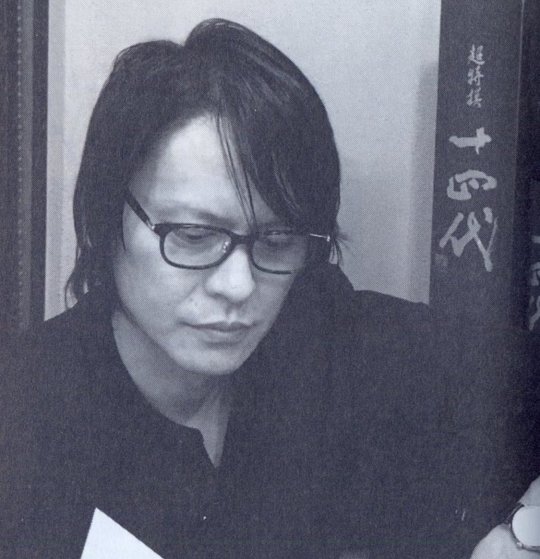
List of books and movies mentioned by Acchan!
Might post an anime version of this soon <3
BOOKS:
仮面の告白 “Confessions of a Mask” by Yukio Mishima (1949)
生きるヒント “Living Tips” by Itsuki Hiroyuki (1993)
斜陽 “The Setting Sun” by Osamu Dazai (1947)
“The Picture of Dorian Gray” by Oscar Wilde (1890)
こころ”Heart” by Natsume Soseki (1914)
“Crime and Punishment” by Fyodor Dostoevsky (1866)
人間失格“No Longer Human” by Osamu Dazai (1948)
死霊“Death Spirits” by Yutaka Haniya (1948)
猫鳴り “Neko Nari” by Numata Mahokaru (2007)
“Coin Locker Babies” by Ryu Murakami (1980)
グロテスク “Grotesque” by Natsuo Kirino (2003)
“Notes from Underground” by Fyodor Dostoevsky (1864)
“The Brothers Karamazov” by Fyodor Dostoevsky (1879-1880)
“Salomé” by Oscar Wilde (1891)
破局 “Catastrophe” by Tono Haruka (2020)
新宿鮫 “Shinjuku Shark” by Arimasa Osawa (1990)
堕落論 “Discourse on Decadence” by Ango Sakaguchi (1946)
五分後の世界 “The World Five Minutes from Now” by Ryu Murakami (1994)
*Manga*悪魔の花嫁 “Bride of Deimos” by Etsuko Ikeda, illust. By Yuuho Ashibe (1974-1990)
九月が永遠に続けば “To Continue Forever in September” by Numata Mahokaru (2005)
彼女がその名を知らない鳥たち “Birds Without Names” by Numata Mahokaru (2006)
銀河鉄道の夜 “Night on the Galactic Railroad” by Kenji Miyazawa (1927)
怒り”Rage” by Shuichi Yoshida (2014)
悪人 “Villain” by Shuichi Yoshida (2007)
MOVIES:
The Green Mile by Frank Darabont (1999)
Bohemian Rhapsody by Bryan Singer (2018)
The Godfather by Francis Ford Coppola (1972)
Pierrot the Fool by Jean-Luc Godard (1965)
The Elephant Man by David Lynch (1980)
老ナルキソス Old Narcissus by Tsuyoshi Shouji (2023)
時計は生きていたThe Clock was Alive by Seijiro Kouyama (1973)
The Mission by Roland Joffé (1986)
Poongsan by Juhn Jai-Hong (2011)
Midnight FM by Kim Sang-man (2010)
Pusher by Nicolas Winding Refn (1996)
Misery by Rob Reiner (1990)
From Paris with Love by Pierre Morel (2010)
異人たちとの夏 The Discarnates by Nobuhiko Obayashi (1988)
Purple Noon by René Clément (1960)
Bonnie and Clyde by Arthur Penn (1967)
狂い咲きサンダーロード Crazy Thunder Road by Gakuryuu Ishii (1980)
Undo by Shunji Iwai (1994)
犬神家の一族 The Inugami Family by Kon Ichikawa (1976)
The Shawshank Redemption by Frank Darabont (1994)
The Brave by Johnny Depp (1997)
Antartica (Nankyoku Monogatari) by Koreyoshi Kurahara (1983)
Here is the link to my actual twitter thread, I update it every time I run into a new book or movie he has mentioned! The information to make this list was taken from several inerviews, radio programs, and even some of the Fish Tank Bulletins. If you know any other book/movie he has mentioned but is not here, do not hesitate to let me know!
ENJOY!
105 notes
·
View notes
Text
Batman: The Animated Series Harley Quinn being the Blueprint for Modern Harley Quinn
my actual version of this post
Working On The Side Of / With The Batfam
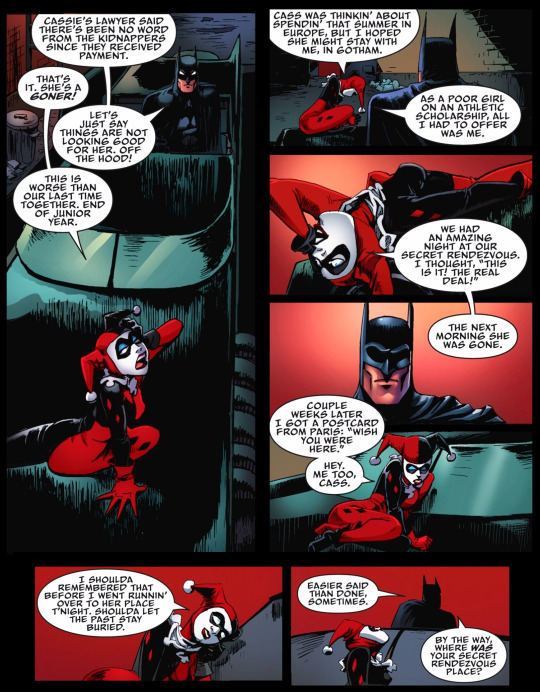

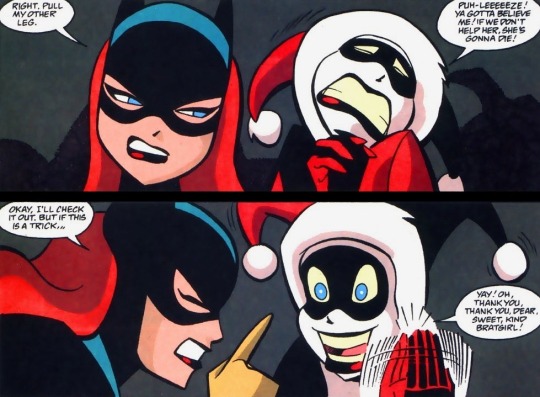
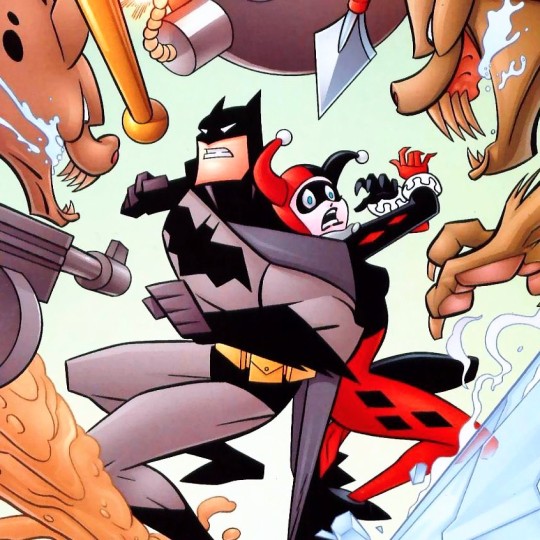
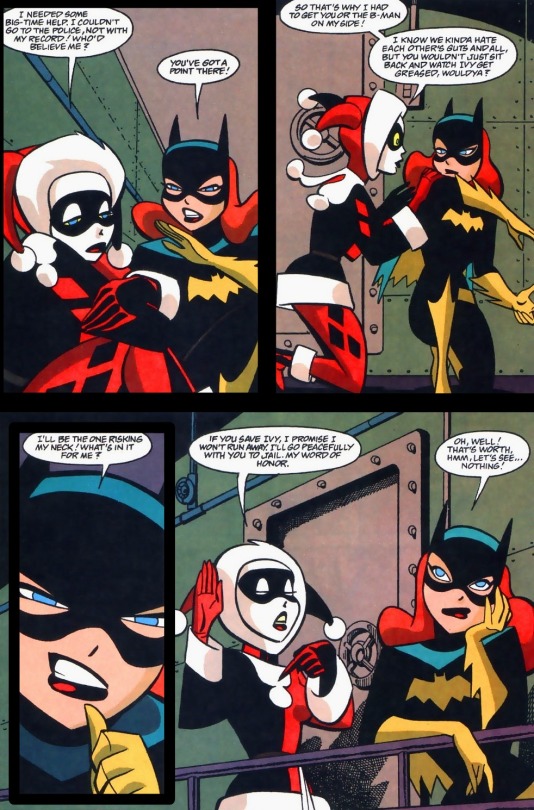

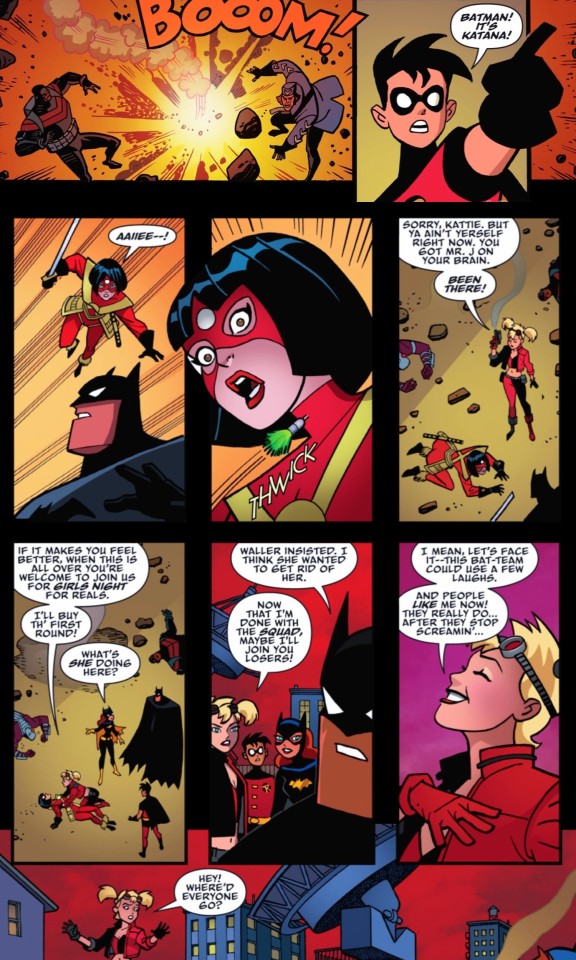
Harlequinade (EP) • "Batman and Robin have no time to spare in stopping the Joker from detonating an atomic bomb, so they enlist the help of Harley Quinn to hunt the Joker down."
Batgirl Adventures • "When Poison Ivy is captured by mobsters, Harley Quinn must act quickly to save her, so she turns to the only hero she can find: Batgirl!"
Batman: Gotham Adventures #43 • "Who's out to get Harley Quinn? Batman has to take her on as a sidekick to find out. The answer awaits deep in Harley's history...that is, if she and the Dark Knight survive the traps set for them all over Gotham!"
Batman: The Adventures Continue Season 1 (2020) #12 | Season 3 #2, #5, #7
-
Also before anyone comes @ me all "oh but what about her participating in the Death in the Family storyline", I've made a post here talking about the exacts of Harley's involvement in Jason's death.
Trying To Have A Better, Reformed Life / Redemption Arc
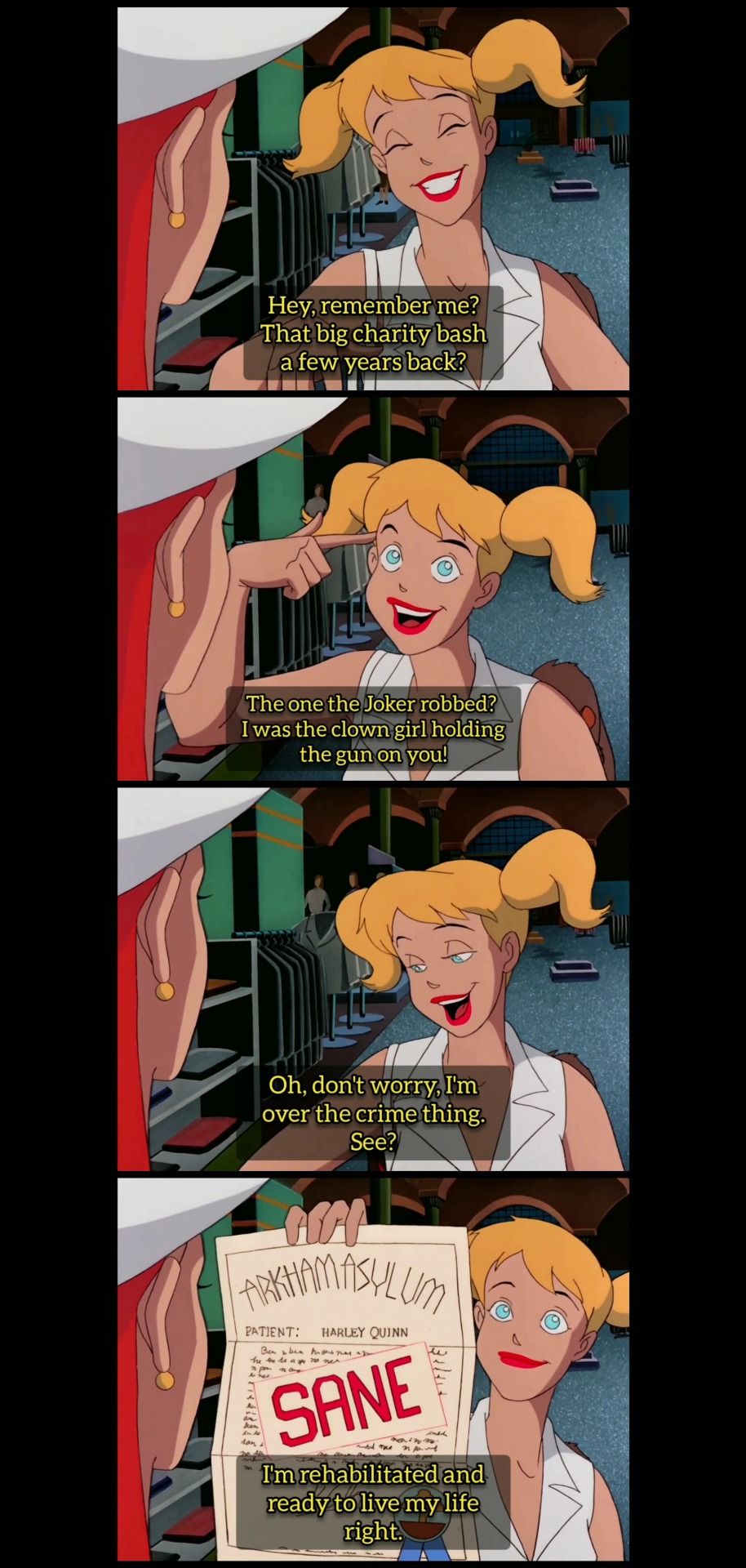
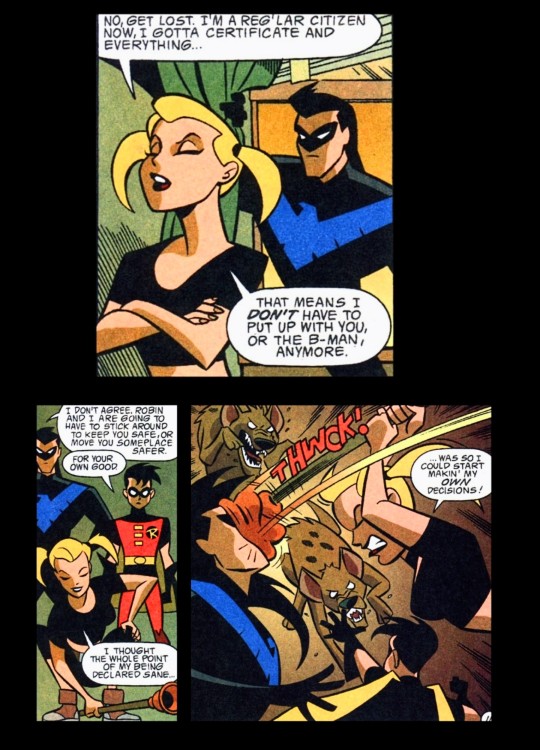
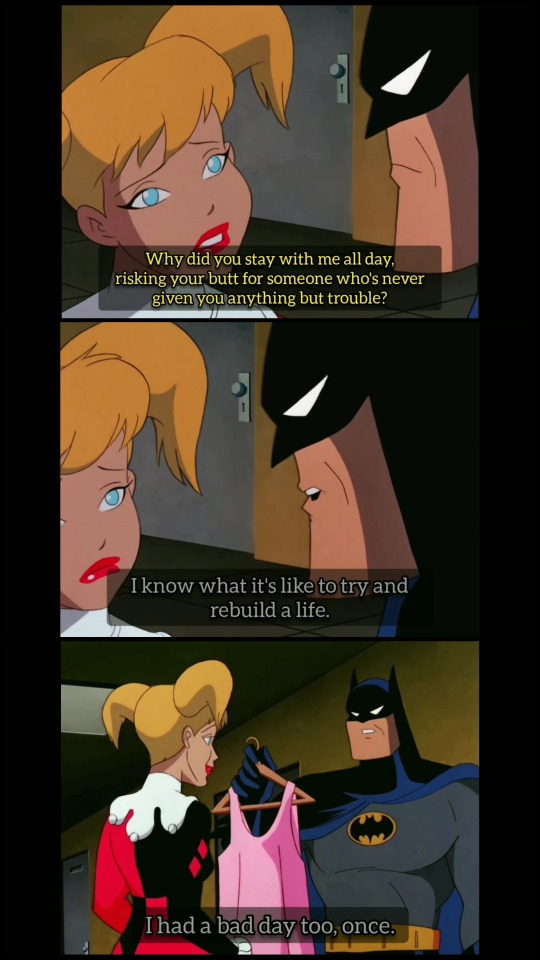
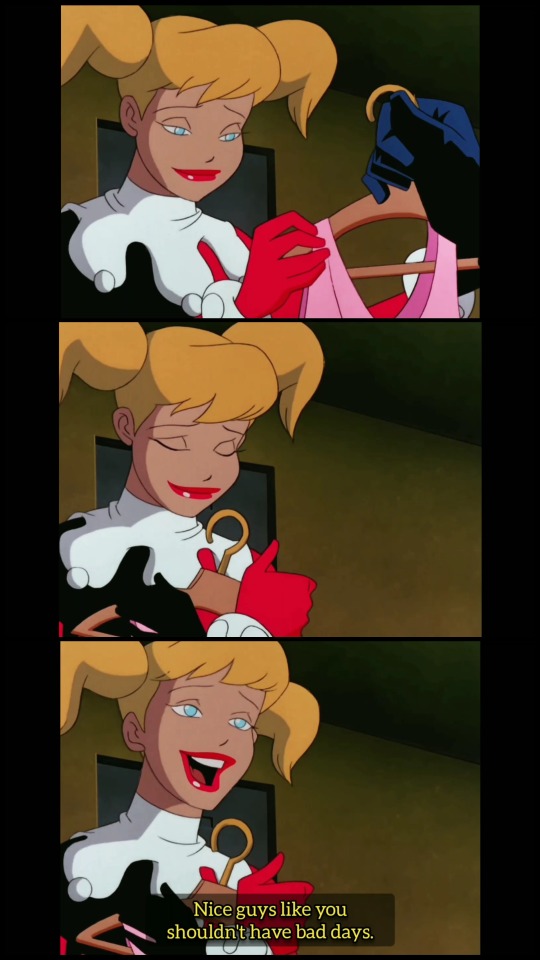
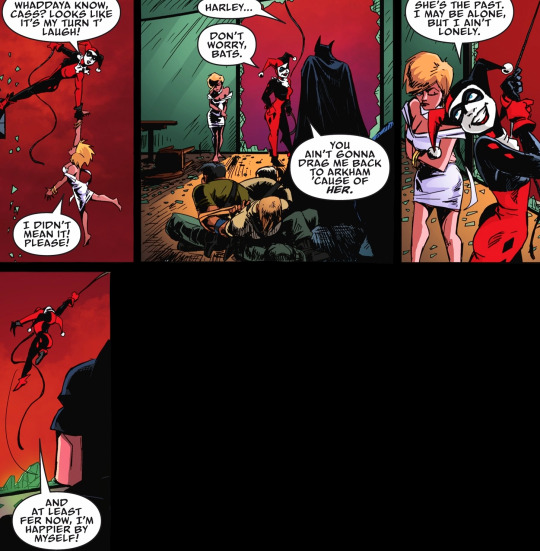

Batman: The Animated Series "Harley's Holiday"
Batman: Gotham Adventures #10
Batman: The Adventures Continue Season 3 (2023) #2
Ending Scene In Batman Beyond: Return Of The Joker
Being A Little Goofy Gal
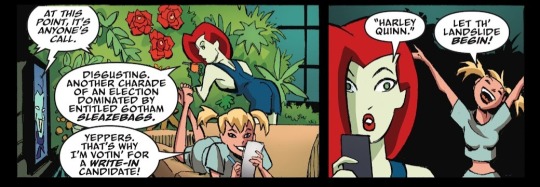

Batman: The Adventures Continue Season 2 (2020) #7
Batman: The Animated Series • "Holiday Knights", "Harlequinade", "The Man Who Killed Batman"
Dressing Revealingly / Being Sexual

Batman: The Animated Series • "Harley & Ivy", "Harley's Holiday", "Holiday Knights", "Beware The Creeper"
The Batman Adventures: Mad Love
Being Bisexual (cry about it♡)
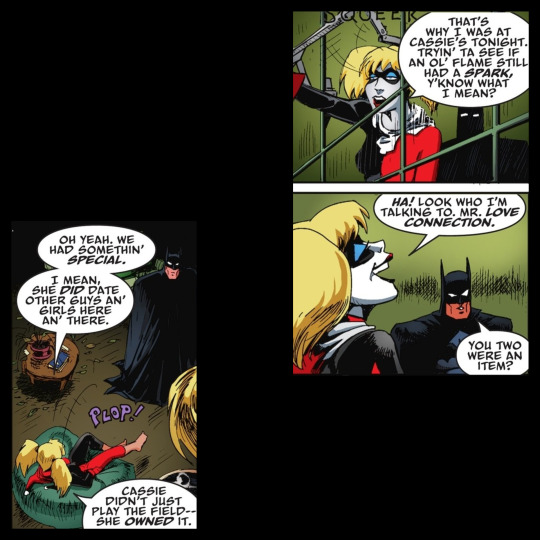
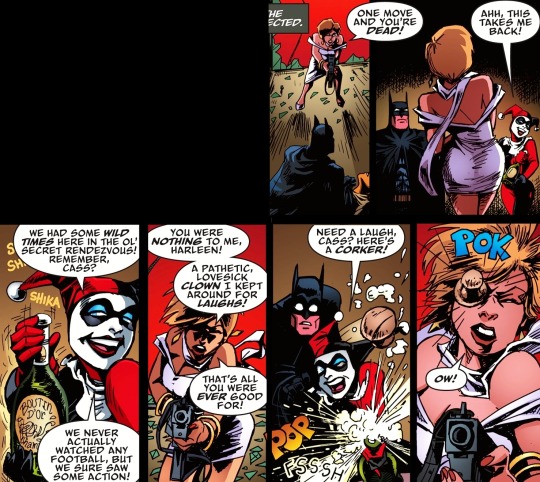
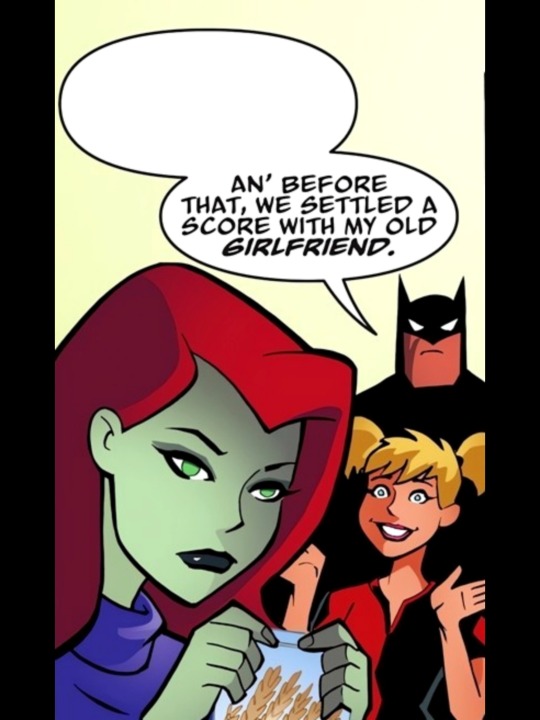
Paul Dini: When Bruce and I did the Harley and Ivy miniseries, it was certainly implied that [Ivy and Harley] had a relationship with each other—they shared hugs and kisses. I didn’t want that to overpower what the story was, but the relationship between them is so natural.

Paul Dini: The more I worked with [Harley Quinn and Poison Ivy], the more I could see [a romantic relationship] happening. Unfortunately, at the time, in an animated kids cartoon, you really couldn’t get into the complexity of that or honor what a relationship like that could really be. We just showed them together as friends and on fairly intimate terms when they were out of the costume, but nothing was implicit because if we couldn’t do that relationship properly then we didn’t want to do it at all.
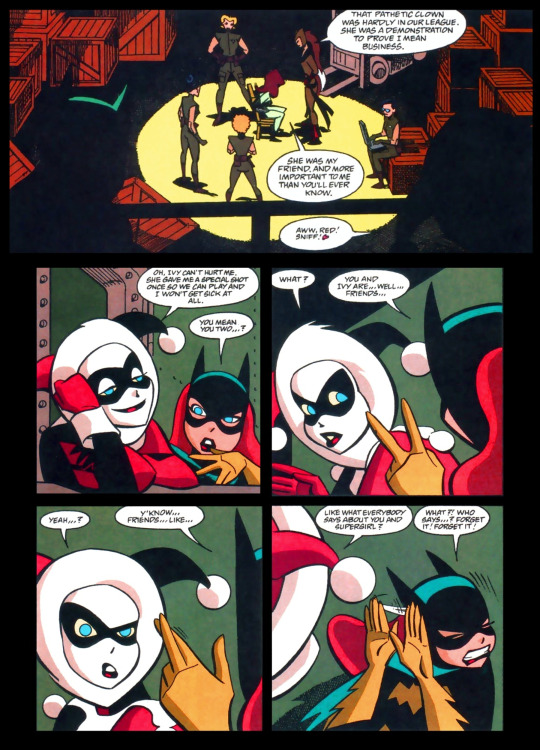
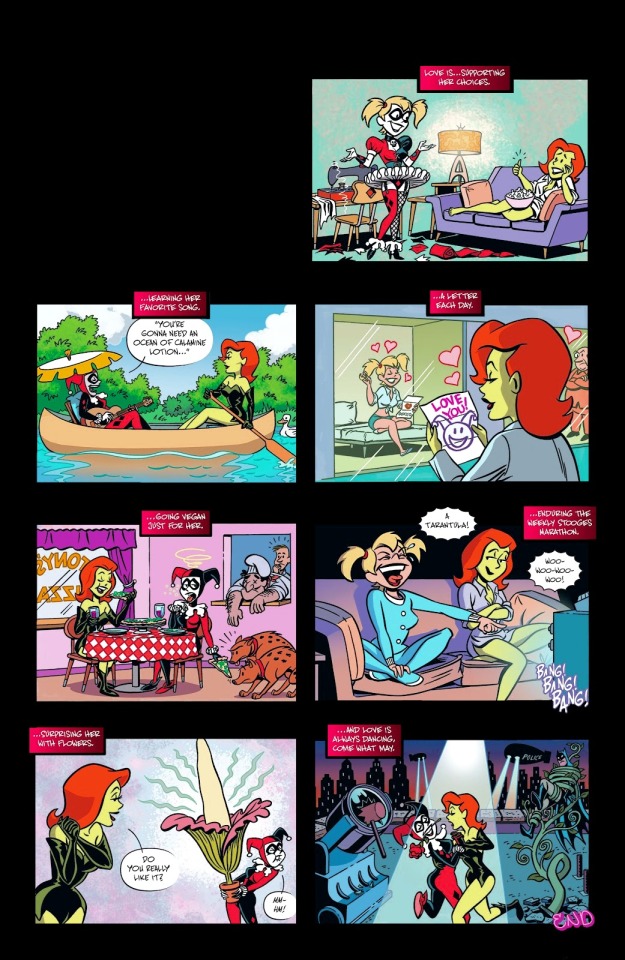
Batman: The Animated Series • "Holiday Knights"
Batgirl Adventures (1997)
Love Is Love (2016)
Batman: The Adventures Continue Season 3 #2-7
Breaking The Fourth Wall

Batman: The Animated Series • "Harley's Holiday"
HQ, turning her head towards the camera: "Talk about grasping at straws. Oh, well, at least I'm going out on a joke."
Being A Domestic Violence Victim (And That Being A Prevalent Aspect Of Her Story)

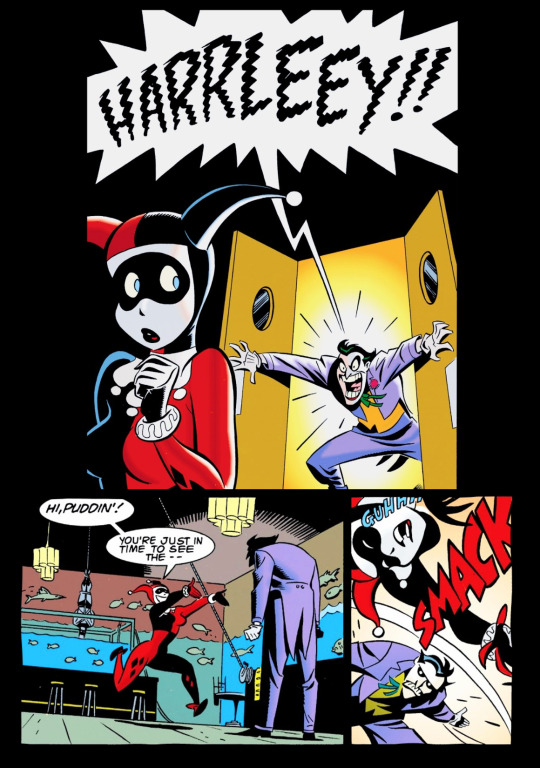
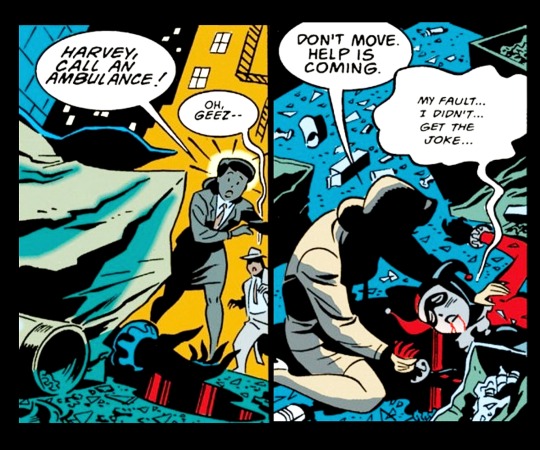
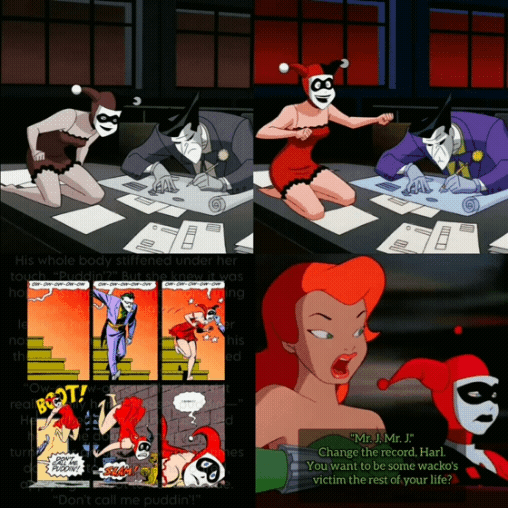
"Everyone else sees the Joker laugh, only Harley has ever seen him cry. It's the only reason she stays with him.
Harleen, having once been a therapist, has touched onto his vulnerability. She knows who he is underneath. That’s what keeps her there."
- Arleen Sorkin [Batman: Animated | Interview Add-On Comment]
Batman: The Animated Series • "The Laughing Fish", "Harley & Ivy", "Mad Love"
Justice League • "Wild Cards"
The Batman Adventures: Mad Love (comic)
Harley Quinn: Mad Love (Novel)
Batman: The Animated Series | The New Batman Adventures Episodes
Harlequinade Aired: May 23, 1994 Writer: Paul Dini Director: Kevin Altieri
Harley's Holiday Aired: October 15, 1994 Writer: Paul Dini Director: Kevin Altieri
Holiday Knights Aired: September 13, 1997 Writer: Paul Dini Director: Dan Riba
The Man Who Killed Batman Aired: February 1, 1993 Writer: Paul Dini Director: Bruce Timm
Harley & Ivy Aired: January 18, 1993 Writer: Paul Dini Director: Boyd Kirkland
Beware The Creeper Aired: November 7, 1998 Writer: Rich Fogel Story by: Steve Gerber Director: Dan Riba
The Laughing Fish Aired: January 10, 1993 Writer: Paul Dini Director: Bruce Timm
Mad Love Aired: January 16, 1999 Writer: Paul Dini Story by: Bruce Timm & Paul Dini Director: Butch Lukic
Justice League Wild Cards Aired: December 6, 2003 Writer: Stan Berkowitz and Dwayne McDuffie Director: Butch Lukic
Ending Scene In Batman Beyond: Return Of The Joker Story: Paul Dini, Glen Murakami, Bruce Timm Screenplay: Paul Dini Director: Curt Geda
The Batman Adventures: Mad Love Writers: Paul Dini, Bruce Timm Pencilers: Bruce Timm Inkers: Bruce Timm Colorists: Bruce Timm, Rick Taylor Letterers: Tim Harkins Editors: Scott Peterson, Darren Vincenzo
Batman: Gotham Adventures #43 Writers: Scott Peterson Pencilers: Tim Levins Inkers: Terry Beatty Colorists: Lee Loughridge Letterers: Albert DeGuzman Editors: Joan Hilty, Harvey Richards
Batman: Gotham Adventures #10 Writers: Ty Templeton Pencilers: Rick Burchett Inkers: Terry Beatty Colorists: Lee Loughridge Letterers: Tim Harkins Editors: Darren Vincenzo
Batman: The Adventures Continue Season 1 #12 Writers: Alan Burnett, Paul Dini Pencilers: Ty Templeton Inkers: Ty Templeton Colorists: Monica Kubina Letterers: Josh Reed Editors: Andrew Marino
Batman: The Adventures Continue Season 2 #7 Writers: Alan Burnett, Paul Dini Pencilers: Rick Burchett Inkers: Rick Burchett Colorists: Monica Kubina Letterers: Josh Reed Editors: Andrew Marino
Batman: The Adventures Continue Season 3 #2 Writers: Alan Burnett, Paul Dini Pencilers: Kevin Altieri Inkers: Kevin Altieri Colorists: Monica Kubina Letterers: Josh Reed Editors: Andrew Marino, Ben Meares, Katie Kubert
Batman: The Adventures Continue Season 3 #5 Writers: Alan Burnett, Paul Dini Pencilers: Ty Templeton Inkers: Ty Templeton Colorists: Monica Kubina Letterers: Josh Reed Editors: Ben Meares, Andrew Marino, Katie Kubert
Batman: The Adventures Continue Season 3 #7 Writers: Alan Burnett, Paul Dini Pencilers: Ty Templeton Inkers: Ty Templeton Colorists: Monica Kubina Letterers: Josh Reed Editors: Ben Meares, Andrew Marino, Katie Kubert
Batgirl Adventures (1997) Writers: Paul Dini Pencilers: Rick Burchett Inkers: Rick Burchett Colourists: Rick Taylor Letterers: Albert DeGuzman Editors: Scott Peterson, Darren Vincenzo
Love is Love (2016) Writer: Paul Dini Illustrator: Bill Morrison Colourist: Robert Stanley Letterer: Sal Cipriano
Harley Quinn: Mad Love (Novel) Written By: Pat Cadigan and Paul Dini
I am aware this last one isn't technically in the BTAS universe, but later on in the novel, it blends into the Mad Love comic/episode and then goes past it. I only used scenes that were originally featured in the comic/episode as they are just those scenes in a purely written form.
Harley Quinn: Mad Love (Novel) Pg. 261 He lowered his head and slumped, the very picture of dejection. Harley couldn’t stand to see him that way. She cuddled up next to him and took him in her arms. “I know how to make some smiles, puddin’,” she said in a playful, sultry voice. His whole body stiffened under her touch. “Puddin’?” But she knew it was hopeless; she’d done the wrong thing again. A moment later, he was leading her down the stairs by her nose, pinching it so hard between his thumb and forefinger that she cried out on every step. “Ow-ow-ow-ow-ow! That hurts! It really, really hurts! Please, puddin’—” He pinched even harder as he led her to the door, opened it, then turned her around. “How many times do I have to tell you?” he roared, applying his foot to her backside. “Don’t call me puddin’!” Harley scrambled to her feet just as he slammed the door in her face. She started to beg him to let her in but suddenly all the fight went out of her and she sank down to sit cross-legged in front of the door. Thrown out again; how many times was this? She’d lost count. No, she hadn’t. This was the twenty-fifth time. That averaged out at roughly three times a week for the past two months. - Harley Quinn: Mad Love (Novel) Pg. 255 “Hey, that’s a real gasser, ain’t it, Mistah J?” she said between giggles. In the next moment, Gordon thought the nitrous was making him hallucinate as events took a sharp turn into the surreal. The Joker grabbed the floppy points on Harley’s hat, pulling her to him so they were nose to nose. “I deliver the punchlines around here!” he bellowed into her face. “Got that?” “Yessir,” Harley Quinn said, her voice tiny and fearful. The Joker shoved her aside and the jolly Clown Prince of Crime persona was back.
#extra info under the read more#batman the animated series#btas#dcau#arleen sorkin#tw abuse#tw clown boy#♢ meta & analysis ♢#♡ my gifs ♡#harley quinn#harleen quinzel#dc comics
310 notes
·
View notes
Text
Animal of the Day!
Caspian Tiger (Panthera tigris virgata)
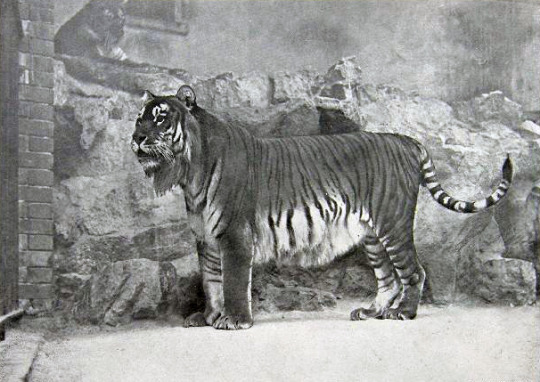
(Photo from Berlin Zoological Garden)
Extinction Date- 2003
Habitat- Middle East; Central Asia
Size (Weight/Length)- 230 kg; 3 m
Diet- Large mammals
Cool Facts- Caspian tigers were the second largest subspecies of tiger. They were made for rocky or forested steps by the Caspian Sea. These tigers were thought to follow migratory herds of deer or pigs. The downfall of the Caspian tiger began when Russia colonized Turkey. Tigers were shot out of fear, diseases swept through the population, and their natural habitat was converted into cotton plantations. The last wild Caspian tiger was captured and killed in 1997. Conservation efforts were attempted, but outside of legal protections little was done to restore their habitat or promote breeding attempts. Today, 6 tiger subspecies remain and all are endangered. Luckily, zoos are working to create captive breeding programs and national parks protect these magnificent creatures.
Rating- 12/10 (Most closely related to the Amur tiger.)
#animal of the day#animals#mammals#tigers#cats#tuesday#october 3#caspian tiger#biology#science#conservation#the more you know#extinct#extinctober#amur tiger
182 notes
·
View notes
Text
H5N1: What to know before fear spreads
What is H5N1?
H5N1 is a 1996 strain of the Spanish or Avian Flu first detected in Chinese birds before spreading globally across various avian species. H5N1 is similar to H1N1, but spreads slower and has a much higher mortality rate.
H5N1 may also be referred to as Influenza A. The American Association of Bovine Practitioners has seen fit to rename H5N1 to Bovine Influenza A Virus, or BIAV, and are encouraging others to use the same terminology.
I would not be surprised if the colloquial name among the public becomes Bovine Flu or American Flu in the coming months, and may be referred to as the Chinese Flu by the same folks who took the spark of the SARS-CoV-2 (COVID-19) pandemic as an excuse to be publicly racist to East Asian people without social repercussions.
BIAV is a virus, meaning that it is a (probably) non-living packet of self-replicating infectious material with a high rate of mutation. BIAV is structured similarly to SARS-CoV-2, having a packet of infectious material encased in a spherical shell with a corona, or crown, of proteins that can latch to living cells to inject RNA.
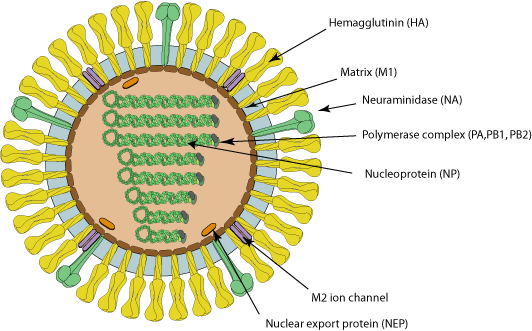
Image source with interactive model: ViralZone - H5N1 subtype
What is the history of BIAV?
In 1996 and 1997, an outbreak of BIAV occurred among poultry and infected 18 people in Hong Kong, 6 of which died. This seemingly isolated incident then infected ~860 people with a >50% death rate.
At the time, BIAV was known as Highly Pathogenic Avian Influenza, or HPAI, and killed nearly 100% of chickens within a 48 hour period.
From 2003 to 2005, continual outbreaks occurred in China and other East Asian countries, before spreading to Cambodia, the Netherlands, Thailand, and Vietnam.
From 2014 to 2016, it began being detected in American fowl, as well as mutating the H5N6 (lethal in birds, no human to human transmission) and H5N8 (largely spread through turkeys, ducks had immunity) viruses.
BIAV has since evolved into a clade known as 2.3.4.4b, and was first detected in 2021 in wild American birds. This then caused outbreaks in 2022 among wild and domesticated birds (such as chickens) alike, but was largely being overshadowed by the pressing SARS-CoV-2 pandemic at the time.
From 2022 to 2023, it was observed to be spreading among various mammals, including humans. Now, in 2024, we're having the most concerning rapid outbreak of BIAV since 2003.
BIAV is known to spread from mammal to mammal, particularly between cows and humans. BIAV may also be spread from cow to cow (highly likely, but not confirmed - this is likely the reason the virus has spread to Idaho from Texan cattle), and is known to be lethal to domestic cats and birds within 48 hours.
How does BIAV spread?
BIAV spreads through fomites - direct contact with infected animals or infected surfaces and then touching parts of your face or other orifices - as well as through airborne particulates, which may be inhaled and enter the sinuses and lungs.
BIAV is known to spread through:
Asymptomatic Ducks, geese, swans, various shorebirds
Symptomatic, may be lethal Foxes, bears, seals, sea lions, polar bears, domestic cats, dogs, minks, goats, cows, (potentially human to human, but unconfirmed - there have only been 8 potential human to human cases in 2024).
How can I protect against BIAV?
As BIAV is a type of Influenza A, existing protocols should do fine.
Current recommendations are to wash your hands vigorously after interacting with birds (I would also recommend doing this with mammals), avoid touching your face or other open orifices, and wear N95 masks.
Avoid sick or dead animals entirely - I would also recommend reporting them to your local Animal Control or veterinary centre and warning them about the infection risk. People who work with animals are recommended to also wear full PPE such as N95 masks, eye protection, gloves, and partake in vigorous hand washing.
If you suspect you've caught BIAV, seek medical attention immediately. Existing medications such as oseltamivir phosphate, zanamivir, peramivir, and baloxavir marboxil can reduce BIAV's ability to replicate.
Standard flu shots will not protect against BIAV. Remember - symptoms of BIAV may not manifest for between 2 to 8 days, and potentially infected people should be monitored for at least 10 days.
How far has BIAV spread?
BIAV is currently a global virus, though the current infection location of note is the United States.
Image Key: Dark red - Countries with humans, poultry and wild birds killed by H5N1 Deep red - Countries with poultry or wild birds killed by H5N1 and has reported human cases of H5N1 Light red - Countries with poultry or wild birds killed by H5N1
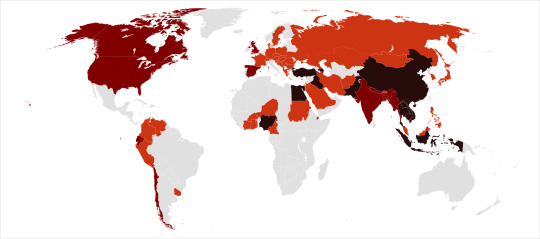
Image source: Wikipedia - Influenza A virus subtype H5N1 - File: Global spread of H5N1 map
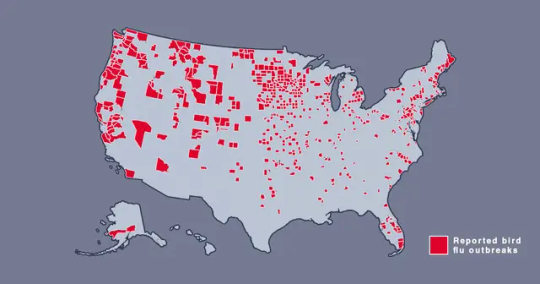
Image source: Metro.co.uk - Map shows where bird flu is spreading in US amid new warning - File: The Centers for Disease Control and Prevention’s H5N1 bird flu detections map across the United States
Should I be afraid?
You needn't be afraid, just prepared. BIAV has a concerningly high lethality, but this ironically culls its spread somewhat.
In the event human to human transmission of BIAV is confirmed, this will likely mainly affect marginalized communities, poor people, and homeless people, who are likely to have less access to medical care, and a higher likelihood of working in jobs that require frequent close human contact, such as fast food or retail jobs.
Given the response to SARS-CoV-2, corporations - and probably the government - may shove a proper response under the rug and refuse to participate in a full quarantine, which may leave people forced to go to work in dangerous conditions.
If this does spread into an epidemic or pandemic, given our extensive knowledge about Influenza, and the US having a backup vaccine for a prior strain of H5N1, a vaccine should be able to be developed relatively quickly and would hopefully be deployed freely without charge - we won't have to worry about a situation like The Stand.
Wash your hands, keep clean, avoid large social gatherings where possible, wear an N95 mask if you can afford them (Remember: Cloth masks are the least protective, but are better than nothing. If you can't afford N95 masks, I recommend wearing a well-fitted cloth mask with a disposable face mask over it to prevent pneumonia from moisture buildup in the disposable mask), support the disabled, poor, and homeless, and stay educated.
We can do better this time.
Further things to check out:
YouTube: MedCram - H5N1 Cattle Outbreak: Background and Currently Known Facts (ft. Roger Seheult, M.D.)
Wikipedia - Influenza A virus subtype H5N1
Maine.gov - Avian Influenza and People
CDC.gov - Technical Report: Highly Pathogenic Avian Influenza A(H5N1) Viruses
Wikipedia - H5N1 genetic structure
realagriculture - Influenza infection in cattle gets new name: Bovine Influenza A Virus (BIAV)
#H5N1#bird flu#avian flu#bovine flu#BIAV#pandemic#epidemic#COVID 19#coronavirus#spanish flu#long post#text post#no id#undescribed#news#politics#us news#us politics#american news#american politics#world news#global news#global politics#world politics#lgbt#lgbtq#queer#trans#communist#socialist
45 notes
·
View notes
Note
hi, I hope you don't mind that. I want make an order. I would like a cult! Sagau fatui harbingers (Pulchinela plantonic, the rest all romantic) for Fem! Creator with character of Nastya (from cartoon Anastasia 1997.) She has a brave, astro smart, kind, short-tempered character. The creator remembers almost nothing about herself, trying to remember her past and who she is. She also has love line with Dottore (and once sorry Y/n hit him hard on the cheek and he was shocked). As in the previous request, you can come up with a continuation of this story. (Pulchinela plantonic, the rest are romantic)
(The closest character I could find is Anya from this moive and I've not seen this movie, so don't judge me).
You're trip to Snezhnaya was coming to an end. The harbingers have kept you mostly inside the palace. Being very boared you plan your escape. Sneaking out at night would work in any other region, but Snezhnaya getting below freezing at night. Sneaking out could still wrok, but it's not a good idea. So, you waited until the harbingers were at a meeting so you could escape.
When you did mange to escape you explored the city. You explored as much as you could. Exploring lead you to the local shrine and statue of the Creator. You had gotten used to people comparing you to her. The freedom you felt was new. You've tried finding out who you are, for as long as you can remember. You're search took you to dead ends. You decide to start serching for answears again. You walk into a city libraryand start looking at the books. The serch leads you to a worn, old looking book. Pulling it off the self you start reading. It is talking about the Creator, and how great they were. It gets boring, untill it mentions the fact that the Creator supposedly died in Snezhnaya. You remeber a young man in Fontanie telling you there was an energy coming from you. Deciding this could be a lead, you plan to go to the spot where the Creator died. Following the route, it ends to a stone. This pissed you off. You had braved the wild winter weather for a stupid rock.
You punched the rock in anger, which then made you feel a tingle run through your body. Looking at the rock, it is now glowing green. The rock breaks open to reval a locket. Putting it on, you feel yourself being sucked into your mind.
In a black void, you see fragments coming together. As the fragments come together you see memories. They show someon who looks like you creating the mountains, animals, and many other things. You think you're having a cold induced delusion. This theory is ruined when you see the figure adress themselves with your name. In Teyvat, no one was allowed to name their child after the Creator, or any other gods. You breathing picks up, your heart beats so hard that your ribs might break. When you get out of your head, you stare at the locket. A beam of light shots out of it. Following the light, you run into monsters that make it their mission to try and kill you. It gets on your nerves so much that you decide to beat the monsters into the ground. When you get to where the locket wanted it's revealed to be another rock.
"Another rock... I think I've lost my mind," You tell yourself.
Getting close to rock, it has words written on it. You stared at the words and you could understand them. Thing is, you never really knew Teyvat's language. You needed others to read things for you, and that made you feel helpless. The rock said, here lays the soul of our god. It wasn't refering to the Tsarita because she was still alive. Touching the rock energy follows through you. It scaes you. Getting to your feet you hear a voice. Looking behind you, you see Dottore.
"I was looking everywhere for you," he scolds.
You had started getting a crush on him over the month. His features and intelligence drew you to him. You saw yourself married to him, if you ignore the human experiments. He drags you back to the palace nad after everything that's happened today, you were not in the mood for this. You yell at him to let you go, but he ignores you.
"Hey! Let me go!" You yell.
He continues to ignore your yelling. This pisses you off even more. You raise your hand, palm open, and full of rage. The next thing Dottore knows, you've slapped him right across the face. He looks at you in shock. There is a staring match between you two. You see how you left a large red mark on his cheek. You lead him inside and to the guest room you were staying in.
"Wait here," You tell him.
He waits for you to come back. When you do come back with an ice pack he smiles a bit. Putting the ice pack on his red cheek he can't help but smile. When he thinks his redness is gone, he leads you to the meeting room. You sit in the seat that has been chosen as yours. The harbingers stare at you, while even more obession than normal. Dottore takes his seat and looks at you.
"Turns out our guest is more than a королева look a like," He says.
There is an unseen tension in the air. Dottore pulls out a vital of your blood.
"When I took this sample, it was red now it is a glowing gold color," He explains. He expalins how he found you in the forest near the rock. Turns out the rock is the grave of the Creator. The relization that you're the Creator hits everyone hard. The harbinger starts worrying that they weren't respecting you enough and you starting panicing because you might have to quit dancing.
"Well, it seems the other archons have not been taking care of you," Pulcinella mutters under his breathe. Pierro stares you in the eyes.
"It seems you will be staying in Senzhnaya until further notice, " he tells you.
Their romantic antics and attention grabbing tactics increase. Even though he now knows you're a god, Pulcinella still treats you like the young lady he sees you as. Your crush on Dottore goes from one sided to mutual. He brags that he is your lover, even if you haven't even kissed yet. Scaramouche treats you a bit more respectful. They never made you stopped dancing, they think it would be to cruel. They try and help you regain knowledge and memories.
In the end, if they weren't obessed before they are now and they never plan on letting you go.
#cult au#sagau#genshin fanfic#creator!reader#sagau lore#genshin x fem!reader#dottore x fem!reader#romantic fatui harbingers#harbingers x fem!reader
98 notes
·
View notes
Text
Some dog movie observations:
The 1990s to like 2010 seems to be the golden age of dog movies. We got Beethoven (1992), Homeward Bound (1993), Air Bud (1997), 101 Dalmatians (1996), Snow Dogs (2002), Because of Winn Dixie (2005), Hotel for Dogs (2009), Beverly Hills Chihuahua (2008) to name a few that I enjoyed. There is also a slew of B-rate movies that while not as good, still have some charm. I will say I think it helps that cgi wasn’t heavily used in movies until the later 2000s and 2010s, and it is my humble opinion that too much cgi ruins the movies. The more tricks the dog actually does on camera, the better. Bonus points if clever camera shots and practical effects are used instead of cgi.
Anything before the 80s? Questionable animal ethics. (The Animal welfare act was passed in 1966, so really anything before then is… wild.)
Now. As we travel into the 2010s-2020s, we see an uptick in copaganda. (Max, Dog, Rescued by Ruby, and a Dogs Journey are some recent ones). We also see an uptick of Really Bad Movies (think like a dog-BAD. Lady and the tramp? WORSE.) we also see a lot of strange indie films about dogs (white god was….. weird.) this is also when the “air buddies” took off to be their own thing, which has turned into an entire studio that makes Bad Dog Movies (and also shows! Pup academy, phantom pups, and one other one on Netflix. They are Bad)
There are also several with like 100 remakes (lassie, benji, where the red fern grows, like 200 different white fangs smh) so I’m not super sure how I’m going to tackle those….
The most popular dog breeds in these movies are probably goldens, labs, German shepherds, Great Danes (! At least 3 so far; marmaduke, the ugly Dachshund, and Chestnut hero of Central Park), old English sheepdogs (! Surprising but there was a few!) and beagles (again at least a few movies). Also, terriers.
Dobermans, Rottweilers, Beaucerons, and German shepherds are top picks for the antagonist characters, or just as Menacing Dogs
There are several I haven’t watched yet because they are not on any streaming service, and I will have to check my library to see if they have any of them to loan. I am looking forward to the Tim Allen shaggy dog (horrifying poster- dog with human eyes photoshopped on), marmaduke (I remember this movie being terrible), cats & dogs (I remember liking these)
Im tempted to try and make a big long video just. Reviewing all the movies I have watched but that is a massive waste of my time and also I have the personality of a shoe so I’m not sure who would actually be interested in watching it. Much to think about.
#dog movie saga#the list is LOOOOONG#there r like 200 movies I haven’t watched#idk if I should like. be more picky#narrow my requirements#idk#I think I’m gonna watch some horror ones tonight#cujo and white dog maybe?
59 notes
·
View notes
Note
my brain is fried i'm so overtired I've cried spontaneously at least once a day for the past three days will you please help a girl out with a soft cozy wholesome movie recc please and thank you
I’m so sorry my dear!! I dug to the depths of a bunch of old tag games and my film tag and this is what I came up with!
when I’m strung out I tend to gravitate to movies that will make me happy-cry so this list will at moments tend in that direction. I tried to sort by what was available to stream now, and the sub-lists are in no particular order
if you have amazon prime (the basic package):
Penelope (2006). highly recommend, a funny little modern fairy tale about a lonely young girl searching for a way to break her curse. this one heals something in my heart
Stardust. also highly recommend! a chaotic fairy tale about true love and what a person would do for it.
Street Gang. the Sesame Street documentary. sometimes people are good and they’re trying to make the world a better place and they’re doing it with their friends.
How To Train Your Dragon. it’s a perfectly executed film and the score and animation is gorgeous. (also available on netflix)
if you have netflix:
Feel the Beat. a dance flick about a seemingly cold-hearted ambitious young woman becoming a dance teacher in her hometown
To All the Boys I’ve Loved Before. so so so rewatchable.
She’s the Man. the funniest movie on this list and possibly of all time. I have never shown this movie to a person who didn’t end up loving it. it’s Shakespeare’s Twelfth Night at boarding school as a soccer movie
if you have tubi?? you might not need a membership I don’t know how tubi works??
The Music Man. some of the best costumes and choreography my favorite age of movie musicals had to offer. a con man comes to a small Iowa town and starts to want to believe in the beautiful lie he’s selling.
Chitty Chitty Bang Bang. this movie was written by Roald Dahl and it is buck wild. widowed inventor and his two children buy a broken down racing car and?? hijinks and musical numbers ensue
if you have disney plus:
Princess Diaries (1&2). we know them, we love them.
Sky High. if you haven’t seen this, I highly recommend it because it is silly fun but it understands the genre it’s playing with.
Newsies (1992). scrappy newsboys form a union, sing songs, punch each other, ???, profit
Holes. the single best adapted book to film ever? the cast commentary is also hilarious
Rodgers and Hammerstein Cinderella (1997). absolutely delightful. Whitney Houston as the godmother! Jason Alexander as the butler! Brandy as Cinderella! Bernadette Peters as the stepmother!
if you feel up for a trip to the library, things to look for:
The Hundred Foot Journey. I only saw this one once but it’s about a family who opens up an Indian restaurant across from a Michelin-starred French restaurant and it’s gorgeous
A League of Their Own (1992). sisters! best friends! married women and their disreputable drunk coach friends!
The Secret Garden (1993). highly recommend! this one fixes me down to my bones.
This Beautiful Fantastic. also highly recommend! a woman who’s afraid of the world falls in love with it.
Secondhand Lions. also highly recommend!! a boy gets dropped off with his great-uncles for the summer, hears possibly made-up stories of their wild and adventurous youth
August Rush. a young musical prodigy searches for his parents.
Sense and Sensibility (1995). if you need Austen energy, this is the one.
Cinderella (2015). this movie is so gentle and so lovely.
Little Women (1994). life is gonna be hard and sad but it’s gonna be beautiful and the love will endure!!!
I hope this helps and I hope you feel better! ❤️❤️
#I didn’t put Far From the Madding Crowd on here because it gets a little fraught in the middle there#but the ending is so so so comforting to me#I didn’t put love and monsters or speed on here because they are full of love BUT they are stressful#more so than the stuff here#asks
69 notes
·
View notes
Note
Why I M O, Pokeshipping is dead. ( kinda hot take, sorry pokeshippers. ) So, pokeshipping. The very 1st ship in the Pokemon anime’s history. I personally am not a fan of it, I did watch the original anime, and I personally don’t like misty’s character. It was off putting to me.
Now as to what your here for, what killed pokeshipping. There are 3 main contributors to the death of pokeshipping.
1.) The length of time from when misty was replaced to now,
2.) Serena and Amourshipping
3.) The Pokémon sun and moon anime
The length of time from when misty was replaced to now. Now while this might not have been much of an issue if the other 2 bullet points didn’t exist, it has been over a decade at this point, since we last saw misty, meaning that we have a severe lack in character development, and that gives time for other potentially better ships to be created, which leads me to my next point,
Serena and Amourshipping. Possibly one of the biggest ships right now, (which at this point isn’t going to fizzle out anytime soon. ) With Amourshipping going so far, as to introduce a major plot point in ash’s story by having Serena be his childhood acquaintance, many other points that multiple poketubers like Catch ‘Em All Saul, bring up in their videos from years past, to the kiss, and even the writers basically confirming the darn thing.
Amourshipping Confirmed?
So at this point, ( unless they throw all that away, which please. Don’t. ) there is next to no hope of pokeshipping to ever become cannon, which is only further proven by my last point,
The Pokémon sun and moon anime. Now, this is honestly the iceberg that sank the ship, because Brock and Misty returned twice in the Sun and Moon anime, which I’m pretty sure was for let’s go promotion. Now this is where all hope is lost for pokeshipping because even though they returned twice, Misty had literally zero emotional moments with ash whatsoever. No pokeshipping pandering, no flashbacks, nothing. Here’s another video explaining that further.
They did Misty DIRTY!
Now while the only good thing to come out of the re-return episodes was Brock possibly finally finding a girlfriend,
Brock x Olivia
This was the point of no return for Misty and pokeshipping in general. Misty, even though she returned twice, in the most recent anime, had literally no development, and nothing to show how she grew as a character since her absence, her return seems pointless and devoid of substance, and with another ship still gaining popularity at an exponential rate, I’m sorry pokeshippers, but,
It’s time to pay your respects, and move on.
RIP pokeshipping
1997-2023
This is so weird.
I watched the anime, and I found Serena far more off-putting than Misty, since...she inexplicably had some bizarre backstory with Ash (despite being from Kalos), and that backstory was "she knew him for like five minutes but still has a crush on him for some reason". It doesn't help that instead of talking out her issues with Rhyhorn Racing with her mother like a normal person, she just bitches out her mom. But I figured, hey, a point for growth!
Then that didn't happen. Her crush ended up so overblown and obsessive it didn't feel natural (especially not for a ten year old), and her mother was proven right in the end about Serena giving up on stuff too easily. Also, the person Serena ACTUALLY had chemistry with (Shauna) was shoved aside in order to try and force @mourshipping.
Also the idea that Pokeshipping is dead due to Misty's return in SuMo (years ago) is...a wild take.
Additionally, Misty also returned in Journeys.
Also Ash isn't even in the anime anymore???
Anyway! Since this is pretty easy to check:

Pokeshipping is the top Pokeani ship on AO3. It's followed in second place by Journeyshipping. The platonic relationship between Ash and Pikachu has more fics on AO3 than @mourshipping does. If Pokeshipping is REALLY dying out in favor of @mourshipping, then why does @mourshipping have less fics on AO3 than BOTH Pokeshipping AND Journeyshipping?
#anon#fandumb#ao3#pokemon#pokeani#anti amourshipping#pokeshipping#unhinged anon#i have my suspicions abt this anon
18 notes
·
View notes
Text

Taqqiq, the moon spirit [Inuit mythology]
Ever-present in the night sky, the moon plays a central role in countless folktales and myths from around the world. In native Inuit religion, the moon is inhabited by an Inua (supernatural spirit) named Taqqiq, which literally means ‘moon’. This enigmatic but benevolent creature watches over humanity and is responsible for guiding the souls of the dead to the afterlife. He once was a mortal man, and his transformation into the moon spirit is the subject of several different stories. Details differ, but a common version has it that he lusted after his own sister, Siqiniq. According to one tale, he made his advances at night, when it was too dark for her to recognize him. But Siqiniq was clever and smeared her body with black soot. The next morning, she saw Taqqiq’s face was blackened with soot and realized that it had been him. He chased her and she fled into the heavens and turned into the sun spirit.
Taqqiq, still chasing after her, followed his sister into the sky and eventually became the moon spirit, ironically reflecting his sister’s fate. He deeply regrets his actions and tries to make up for them. Perhaps because of this, he is said to sometimes descend to the Earth when women are abused and then saves them. Sometimes, he takes them back with him to the moon, where they live happily as Taqqiq takes care of them.
His outfit is made with gorgeous white fur, and Taqqiq himself is said to be particularly handsome. In some stories, he is said to travel with a troupe of dogs. It is unclear to me where these dogs came from, but they are particularly powerful and large.
The moon spirit is also associated with the hunt: the Polar Inuit believe Taqqiq brought wild animals to the world of the living so that humans could hunt and eat (hunters would sometimes offer prayers to thank him), and in the belief of the Inuit of Baffin Island, these animals are specifically mentioned to be caribou and seals. Iglulik Inuit believe that Taqqiq would bestow good fortune on seal hunters, whereas the people from eastern Greenland believe him to bless whale hunters. Taqqiq is often depicted with his signature whip, which he uses to hit young boys, as it is his role as a spirit to harden them into strong hunters. While this is a harsh (and presumably very traumatic) way to teach a kid a lesson, Taqqiq is regarded as a protector of young boys and defender of the weak.
Source: Taylor, J. G., 1997, Deconstructing deities: Tuurngatsuak and Tuurngaatsuk in Labrador Inuit Religion, Études Inuit Studies, 21 (1/2), pp. 141-158. Christopher, N., 2013, The Hidden: a compendium of arctic giants, dwarves, gnomes, trolls, faeries, and other strange beings from Inuit oral history, 191 pp, p. 178-181. D’Anglure, B. S. and Philibert, J., 1993, The Shaman’s Share, or Inuit Sexual Communism in the Canadian Central Arctic, Anthropologica, Canadian Anthropology Society, 35 (1), pp. 59-103. (image source: Christopher Stevens, painted for Pivut Magazine, Copyright Inhabit Media)
46 notes
·
View notes
Text
Animation Night 193 - Harpier cries: 'tis time! 'tis time!
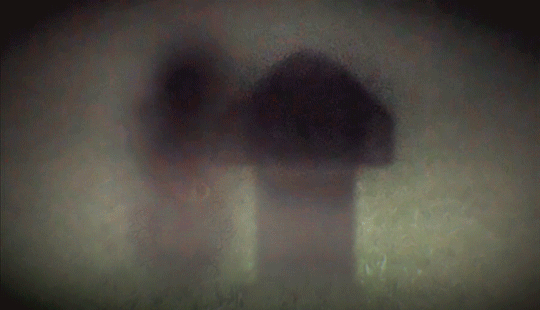
PREVIOUSLY, in the dark halls of ANIMATION NIGHT, you have born witness to such horrors as these...
Animation Night 25: HORROR, featuring Kakurenbo, Vampire Hunter D: Bloodlust, Birdboy: The Forgotten Children, and many episodes of Yamishibai
Animation Night 77: Once More, Halloween, featuring Blood: The Last Vampire, Seoul Station, The Wolf House, and Shoujo Tsubaki - and more Yamishibai...
Animation Night 129: Thrice the brinded cat hath mewed..., featuring Hellsing Ultimate, The Secret Adventures of Tom Thumb, Mad God, Ujicha's Violence Voyager, and guess what? Yamishibai...
Animation Night 176: The Hedge-Pigge Whin'd, a rather scuffed production which, contra the writeup, ended up just showing the Darkstalkers OVA from 1997. And some Yamishibai of course.
And now, my friends, and now... the witching hour is soon to be upon us once more, and it is time we revelled in the darkness and terror, for tonight is hallow'een, easily the best festival in the western calendar.
Many thanks go to @glitch-critter and @muzothecat, who provided me some excellent suggestions for animated horror that I have yet to see. Not that reruns would be the end of the world, there's some excellent shit on the list above I would be immensely glad to see again.

To begin with, we have the recently-released The Birth of Kitarō: The Mystery of GeGeGe (幾多郎誕生:ゲゲゲの謎). Which provides an excellent excuse to get into the subject of Kitarou. So let's begin our dark and sordid tale... well, it's actually a pretty positive tale, but that's not really in the spirit of things.
GeGeGe no Kitarō is a truly classic manga series dating back to the 60s, created by Shigeru Mizuki. But it's actually older still: the earliest incarnation of Kitarō is in a kamishibai performance written/illus. by Masami Itō and Keiyō Tatsumi back in 1933, called Hakaba Kitarō (Kitarō of the Graveyard). It tells the story of a ghost boy called Kitarō who lives in a graveyard; like many kamishibai it was aiming at straight up horror. Here's a board from the original (photo by translator Zack Davisson, thanks wikipedia):
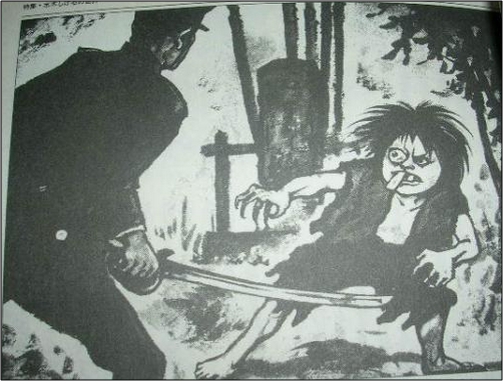
So, you know yōkai? You're reading this blog, so probably, but just in case, they are the various freaky spirits of Japanese folklore, from kappa and tengu to nekomata and chōchin-oiwa. And the reason why they are such a popular feature of modern popular culture (you all know what a kappa is, right?) is in large part due to this manga.
Shigeru Mizuki, born 1922, had a pretty wild life. He was drafted into the army in 1943 at age 21, and lost his left arm in a bombing the next year; during his recovery he made friends among the Tolai people of New Guinea. He came home after the war, and found work renting out an apartment building and drawing kamishibai on the side; gradually the kamishibai work took over. In 1953, his brother Sōhei moved in after being tried for war crimes (the timeline does not mention the outcome of the trial); in 1957 at age 35 he moved to drawing manga, debuting in rental manga with Rocketman.
Starting in 1960 at the behest of Mizuki's publisher, the Hakaba Kitarō manga adapted the story of the yamishibai, introducing a wider audience to ghost boy Kitarō with his floofy hair and little third eye on a stalk. It proved explosively popular (despite being at first deemed too scary for children), telling the stories of Kitarō's encounters with all kinds of yōkai. The state of English translations is a bit scattershot; some of it is available on mangadex.
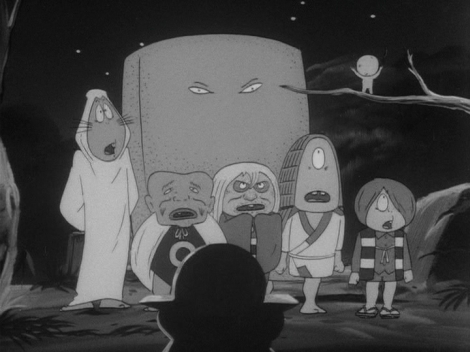
In 1964, at age 42, Mizuki debuted in serialised manga in Garo magazine - a name you might find familiar, the avant-garde magazine which also published authors like Suehiro Maruo (ero-guro mangaka, the author of Shoujo Tsubaki) and Hiroshi Masamura (the guy who made the cat manga we looked into on AN188). There, he rebooted the Kitarō manga, starting once again with the story of the birth of Kitarō. Before long he jumped over to the much larger Monthly Shonen Magazine, and retooled Kitarō to be more kid-oriented. From then on it's Kitarō city - and the immense success of the manga gave him the chance to regularly return to the newly combined state of Papua New Guinea.
In 1968, Kitarō arrived in animation land, one of Toei's early projects. It quickly became one of those classic famous Toei anime, you know the type, the kind of thing that every Japanese person of a certain age would have seen on TV. Mizuki himself composed the OP, and it continued to get sequels throughout the ensuing fifty years, with the most recent being in 2018. This is an old and widely beloved anime so there is a lot of it: the 1968 series accumulated 65 episodes, the third series in 1985-88 is the longest at 115, but the others are no slouch either; even the 2018 series pulled out a mighty 97.
As such, it's... perhaps a little daunting! But...
The Birth of Kitarō is a prequel to the 2018 series... and rather than being a spooky-fun kids anime, it's intended as a genuine horror story aimed at adults, presumably adults who grew up watching Kitarō, returning to the earliest Garo-era tone of the manga. Set in the 50s, the story sees salaryman Mizuki arrive in a village in pursuit of a mysterious medicine, where he finds the village ruled by an old superstitious family. Naturally, before long, murders start happening. And a mysterious white-haired man is somehow involved...
Seems like the perfect way to get into Kitarō. I missed the chance to see this film at Annecy this year, but it's already out on nyaa, so let's jump on it.
So that's our first act. What of our second?

Junk Head is a stop-motion scifi film pretty much enitrely solo animated by Takehide Hori who, at age 40, heard about Makoto Shinkai's solo-animated film Voices of a Distant Star (AN44), and was inspired to spend the next seven years working on a stop-motion scifi epic of his own. It tells of a cyborg from a future where humans have lost the ability to reproduce, venturing into a strange underground realm full of freaky creatures that, I'm told, invite comparisons to the art of Giger, Bosch, Escher and Gorey, and the films of Švankmajer (whose Alice we watched on AN50), Gilliam, and the Quay Brothers. del Toro lauded it as a 'work of deranged brilliance'.
Which is to say this is exactly the kind of thing we like to show here on Animation Night. I can't believe I didn't hear of this film before. Sources are not exactly abundant, but I was able to find a hardsubbed 720p version with a few seeds on it, so that's what we'll be watching tonight.
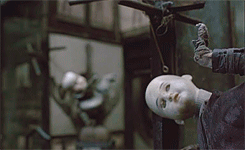
Speaking of the Brothers Quay, who enjoy a remarkably in-depth and thorough wiki page, they have yet to appear on Animation Night, and it's about time we remedied that! A pair of identical twins from the Pennsylvania who moved to the UK in 1969 to study at the RCA, they got their start in illustration before making a turn to stop motion film using bits of dolls and various other materials in the vein of Švankmajer.
They are incredibly prolific as a pair, making shorts in nearly every year from 1979 to 2021 (bar a couple of hiatuses). Most of their films are without dialogue, set instead to the music of Leszek Jankowski and a great many other other composers. They are huge book nerds too, adapting authors from Lem and Kafka to Emma Hauck; honestly there's a ton to dive into here and I will for sure be returning to these guys on a future Animation Night. Tonight, however, our pick will be Street of Crocodiles (2021), a musical piece in which a puppet walks through a desolate realm of "mechanical realities and manufactured pleasures", widely celebrated as one of their best films.
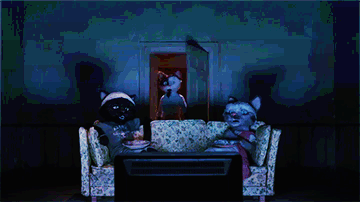
Stop motion seems to be a theme tonight, huh? Somehow, stop motion is just spookier than traditional animation. That theme continues with The House, an anthology piece for Netflix depicting three different stories taking place in the same house. Animated in London, each piece brings in a different director, respectively Emme de Swaef and Marc James Roels co-directing the first, Swedish director Niki Lindroth von Bahr the second and Mexican-British actress turned director Paloma Baeza for the third.
The stories span a few hundred years, from the 1800s to a flooded post climate change future. In each case, the house is the stage for tales of obsession and misguided ambition leading to disaster, whether it should befall anthro rats, humans or anthro cats. Widely praised for its animation and general weirdness, I'm quite excited to see what this mix has in store.
And returning of course will be Yamishibai, the wonderful long-running series of ridiculous cutout-animated creepypasta horror in the vein of old-school kamishibai boards. You know we gotta. And hey, if we're feeling in a really good mood at the end of the evening, I might bring Shoujo Tsubaki out of the vaults too. We shall see.
Animation Night 193 shall begin, with its gruesome course of animated horrors, at seventh hour.... which is to say 7pm UK time, just over four hours from the writing of this post. Be there, or be forever haunted by the ghosts of frames unseen (unless you gotta go trick or treat or something, we understand). The place? Upon the heath... of twitch.tv/canmom!
Hoooohhooohohoohooohooohohoooooooooo!
12 notes
·
View notes
Text
Irish dress history sources online:
A list of sources for Irish dress history research that free to access on the internet:
Primary and period sources:
Text Sources:
Corpus of Electronic Texts (CELT): a database of historical texts from or about Ireland. Most have both their original text and, where applicable, an English translation. Authors include: Francisco de Cuellar, Luke Gernon, John Dymmok, Thomas Gainsford, Fynes Moryson, Edmund Spenser, Laurent Vital, Tadhg Dall Ó hUiginn
Images:
The Edwin Rae Collection: A collection of photographs of Irish carvings dating 1300-1600 taken by art historian Edwin Rae in the mid-20th c. Includes tomb effigies and other figural art.
National Library of Ireland: Has a nice collection of 18th-20th c. Irish art and photographs. Search their catalog or browse their flickr.
Irish Script on Screen: A collection of scans of medieval Irish manuscripts, including The Book of Ballymote.
The Book of Kells: Scans of the whole thing.
The Image of Irelande, with a Discoverie of Woodkarne by John Derricke published 1581. A piece of anti-Irish propaganda that should be used with caution. Illustrations. Complete text.
Secondary sources:
Irish History from Contemporary Sources (1509-1610) by Constantia Maxwell published 1923. Contains a nice collection of primary source quotes, but it sometimes modernizes the 16th c. English in ways that are detrimental to the accuracy, like changing 'cote' to 'coat'. The original text for many of them can be found on CELT, archive.org, or google books.
An Historical Essay on the Dress of the Ancient and Modern Irish By Joseph Cooper Walker published 1788. Makes admirable use of primary sources, but because of Walker's assumption that Irish dress didn't change for the entirety of the Middle Ages, it is significantly flawed in a lot of its conclusions. Mostly only useful now for historiography. I discussed the images in this book here.
Chapter 18: Dress and Personal Adornment from A Smaller Social History of Ancient Ireland by P. W. Joyce published 1906. Suffers from similar problems to An Historical Essay on the Dress of the Ancient and Modern Irish.
Consumption and Material Culture in Sixteenth-Century Ireland Susan Flavin's 2011 doctoral thesis. A valuable source on the kinds of materials that were available in 16th c Ireland.
A Descriptive Catalogue of the Antiquities in the Museum of the Royal Irish Academy Volumes 1 and 2 by William Wilde, published 1863. Obviously outdated, and some of Wilde's conclusions are wrong, because archaeologists didn't know how to date things in the 19th century, but his descriptions of the individual artifacts are worthwhile. Frustratingly, this is still the best catalog available to the public for the National Museum of Ireland Archaeology. Idk why the NMI doesn't have an online catalog, a lot museums do nowadays.
Volume I: Articles of stone, earthen, vegetable and animal materials; and of copper and bronze
Volume 2: A Descriptive Catalogue of the Antiquities of Gold in the Museum of the Royal Irish Academy
A Horsehair Woven Band from County Antrim, Ireland: Clues to the Past from a Later Bronze Age Masterwork by Elizabeth Wincott Heckett 1998
Jewellery, art and symbolism in Medieval Irish society by Mary Deevy in Art and Symbolism in Medieval Europe- Papers of the 'Medieval Europe Brugge 1997' Conference (page 77 of PDF)
Looking the part: dress and civic status and ethnicity in early-modern Ireland by Brid McGrath 2018
Irish Mantles, English Nationalism: Apparel and National Identity in Early Modern English and Irish Texts by John R Ziegler 2013
Dress and ornament in early medieval Ireland - exploring the evidence by Maureen Doyle 2014
Dress and accessories in the early Irish tale, ‘The Wooing of Becfhola’ by Niamh Whitfield 2006
A tenth century cloth from Bogstown Co. Meath by Elizabeth Wincott Heckett 2004
Tertiary Sources:
Medieval Ireland: An Encyclopedia edited by Sean Duffy published 2005
Re-Examining the Evidence: A Study of Medieval Irish Women's Dress from 750 to 900 CE by Alexandra McConnell
#resources#dress history#irish dress#irish history#early medieval#bronze age#textile history#late medieval#16th century#historical dress
102 notes
·
View notes
Text
i have a really odd fanfic idea and i really need to put it out in the open (posting about Wild Kratts on main? oh hell yeah!)
So uh, i was listening to Journey to the Past from the 1997 animated masterpiece that is Anastasia… what if, and PLEASE HEAR ME OUT, Anastasia (1997) AU?
From the way I have been thinking about this (for the last half hour) is that Chris is the lost Prince Christopher, except he doesn't know that because he has absolutely no memory of it because he hit his head while escaping when the monarchy was violently thrown over and it's been so long since that most people assume he died with his parents that night.
Chris only has one item that connects him to his past is a compass and a very familiar voice in the back of his head telling him "so you'll always know how to find me" every time he looks at the blue and silver of the compass.
--
Prince Martin was only fourteen when he took an overcrowded train from the remains of his kingdom to his Grandmother's in France and the last thing he saw of his brother was when Chris fell off while trying to get him onto the train. While he is much older now, and the scars Chris' fingernails left when Martin lost his grip have faded with time, Martin knows his brother's alive he just can't prove it.
#evelyn speaks#this is absolutely insane#wild kratts#wild kratts fanfiction#this skirts a very thin line into RPF#a brilliant idea but i dont think i'm ready for this level of commitment#martin kratt#chris kratt
31 notes
·
View notes
Text

Origin
Harleen (2019) [Comic]
Harley Quinn: Mad Love [Novel]
The New Batman Adventures "Mad Love" [Episode]
Villain -> Emancipation Arc
Batman: The Animated Series
"Harlequinade", "Harley & Ivy", "Harley's Holiday"
Batgirl Adventures (1997)
Detective Comics #831
Harley Quinn: Wild Card (Backstories). [Book]
Batman: Gotham Adventures #10
Batman Secret Files: The Gardener
Injustice: Year Zero #7 - #8, #14
Unofficial Continuation Of Harleen (2019)
Harley Quinn (2000) #1, #2, #4, #6, #12
Harley Quinn: Black + White + Red #1, #3, #14
"Harleen: Red", "Get Yer Story Straight", "Fixer Upper"
Harley Quinn: Make Em Laugh #1, #2
"Headshrink", "Housewarming", "The Lady or The Tiger"
Harley Quinn: Black + White + Redder #2
#2: "Origin Stories For Dummies", [skip middle story], "Coffee And Pie Oh My"
Batman (2016 - ) #105
---
Notes {Mild Spoiler Warning}
Batman (2016 - ) #105
This is in the middle of a story arc, but it doesn't really matter. Only context you need for Harley's part is that she, Batman and a kid named Bao (Clownhunter) were knocked out and brought to Arkham as a part of a separate conflict between Bruce and someone. ❤️
Harley Quinn: Black + White + Red
The first chapter, "Harleen: Red", is connected to and takes place in the Harleen (2019) universe. Best read after Harleen and the unofficial continuation.
The continuation is just parts that Stjepan has posted online over the years, I tried my best to put them in an order that flowed. <3
Batman Secret Files: The Gardener
The full comic isn't Harley centric, but I absolutely adore the way Bella tells the tale of Ivy's origin & meeting Harley, it's a cute part showing their relationship.
Harley Quinn: Wild Card (Backstories)
This one is kinda like a somewhat more detailed cliff notes for kids. Parts of her origin is different and aligned with her Rebirth one, but I think it's great to get a feeling of how her character progresses. Though like I said, it is definitely for a preteen & younger audience so some stuff is watered down. Her relationship with Joker isn't as graphically abusive (he's a toxic little bitch, but not shown being directly physical with her.), and her introduction into the Suicide Squad is more chill and something she agrees to do.
But even with that, I love it! It's got pencil sketches throughout, notes from Harley herself which I think is a lovely detail and added bits about her relationship with Ivy over the years.
Harley Quinn (2000)
#6: this is kinda the beginning of a two chapter plot, but I'm including for stuff in this chapter only.
Also, her characterization during one part that involves Bruce's female bodyguard feels ooc imo, especially considering it's the same writer from #2.
#I'm just go ahead and post this cause its just sitting here on the off chance i think of something else sldnskks#harley quinn#harleen quinzel#dc comics#comic recs
49 notes
·
View notes
Text

Eddie Redmayne as The Jackal. (© 2023 Carnival Film & Television Limited)
What To Expect From The Day Of The Jackal.
By Olivia Emily, for Country& Town House, October 10th, 2024.
Perhaps Hollywood’s shiniest star of the 2010s – starring in the likes of My Week With Marilyn (2011), Les Misérables (2012), The Theory of Everything (2014) and The Danish Girl (2015) – Eddie Redmayne takes on a role unlike any of his others in The Day of the Jackal: an assassin. Here’s exactly what to expect from Sky’s brand new thriller.
The Day Of The Jackal: Plot, Cast, Release Date & More
In the works since 2022, Sky’s flagship series this autumn is this star-studded series. Written by Ronan Bennett and directed by Brian Kirk, Eddie Redmayne has been attached to the project as an executive producer since the very beginning, with the actor describing the original book as ‘reconceived and contemporised with a new target’ for the series. In March 2023, it was confirmed Redmayne would star in the title role, too.
What Is The Day Of The Jackal About?
The Day of the Jackal is a political thriller centring on a ruthless British assassin and the intelligence officer tasked with capturing him. Sky’s synopsis reads: ‘An unrivalled and highly elusive lone assassin, the Jackal (Eddie Redmayne), makes his living carrying out hits for the highest fee. But following his latest kill, he meets his match in a tenacious British intelligence officer (Lashana Lynch) who starts to track down the Jackal in a thrilling cat-and-mouse chase across Europe, leaving destruction in its wake. The series also stars Úrsula Corberó as Nuria, someone at the heart of The Jackal’s personal life, unaware of who he truly is.’
Where Was It Filmed?
The Day of the Jackal was filmed across Europe in 2023, beginning in Budapest in June, before moving to Vienna in July. As autumn drew in, it was over to Croatia, with filming taking place in Rijeka, Pag, Dubrovnik and the Istrian region.
What Is It Based On?
The Day of the Jackal is based on Frederick Forsyth’s 1971 novel of the same name. Critically and commercially acclaimed, Forsyth’s plot whisks us back to 1962 and begins with paramilitary terrorist organisation OAS’s real conspiracy to assassinate Charles de Gaulle, the President of France. In the book, the Jackal is tasked with the job. Forsyth’s novel was an instant bestseller – perhaps because it was published less than a year after the real de Gaulle actually died (of an aneurysm; he wasn’t assassinated). Sky’s series, however, moves the action to contemporary Britain.
If you recognise the plot, that’s because this isn’t the first time The Day of the Jackal has been adapted for the screen: in 1973, Edward Fox portrayed the Jackal in the book’s first film treatment, before Bruce Willis took on the role in the 1997 remake which re-set the action in the US, with the First Lady the assassination target
The Cast
Eddie Redmayne as The Jackal
Lashana Lynch as Bianca
Úrsula Corberó as Nuria
Charles Dance as Timothy Winthorp
Richard Dormer as Norman
Chukwudi Iwuji as Osita Halcrow
Lia Williams as Isabel Kirby
Khalid Abdalla as Ulle Dag Charles
Eleanor Matsuura as Zina Jansone
Jonjo O’Neill as Edward Carver
Sule Rimi as Paul Pullman
What Is A Jackal?
‘Jackal’ is the assassin’s codename in The Day of the Jackal. So what is a ‘jackal’? In the wild, a jackal is a canine mammal, smaller than a wolf but bigger than a fox. Found in Africa, the Middle East, Southeastern Europe and western and south Asia, jackals are opportunistic omnivores and predators of small to medium sized animals and, like foxes, typically hunt and scavenge at dawn and dusk. In conversation, however, to call someone a jackal is to describe them as cunning, dishonest and treacherous – and someone who performs base deeds for another.
How Many Episodes In The Day Of The Jackal?
The Day of the Jackal is a 10-part series, with each episode running for 60 minutes.
Release Date
Episode 1 of The Day of the Jackal will air on Sky Atlantic on Thursday 7 November 2024, and the following episodes will air weekly on Thursdays. The release schedule is as follows:
7 November
14 November
21 November
28 November
5 December
12 December
19 December
26 December
2 January
9 January
Once they have aired on Sky Atlantic, episodes will be available for catch up on NOW.
Over in the US, The Day of the Jackal will launch with the first five episodes on Peacock on 14 November, followed by weekly episodes until a double finale on 12 December.
Source:
#eddie redmayne#eddieredmayne#redmayne#the good nurse#the day of the jackal#new series#sky tv#peacock#country and town house
12 notes
·
View notes